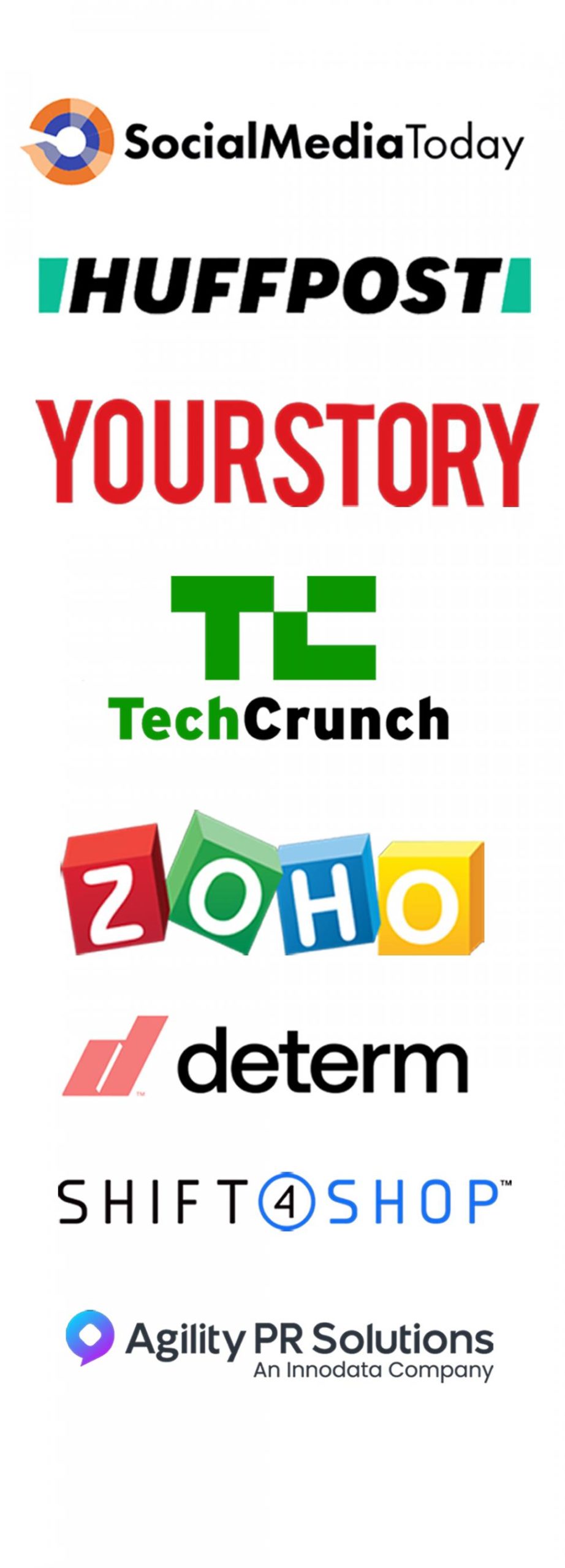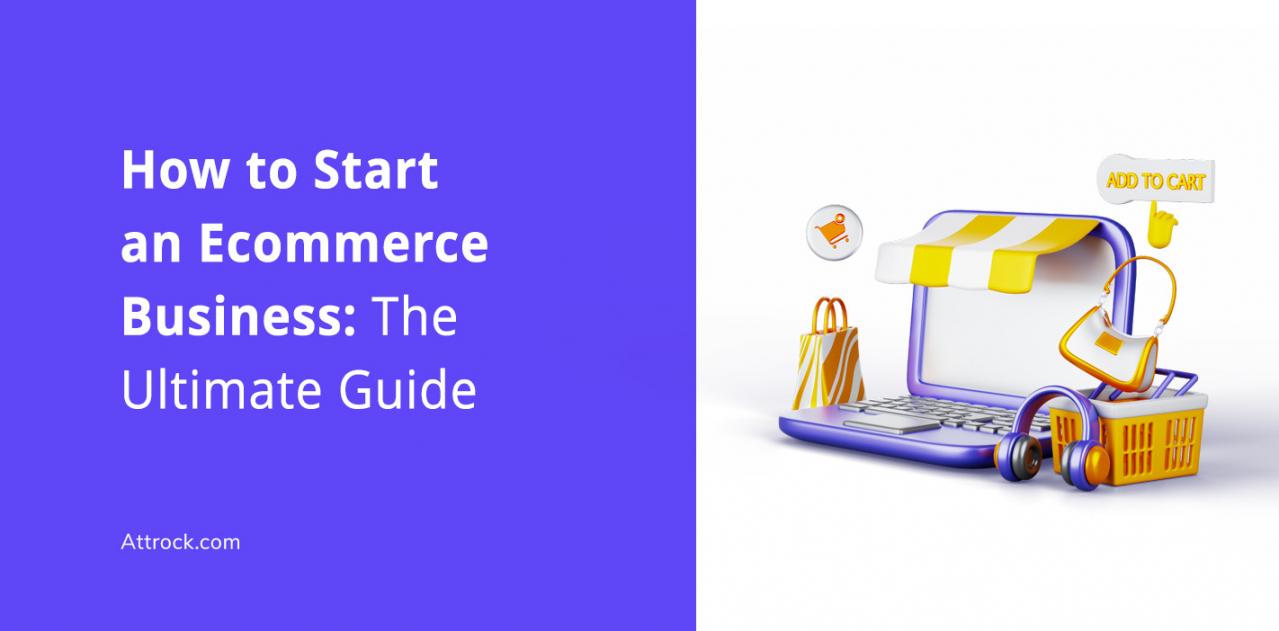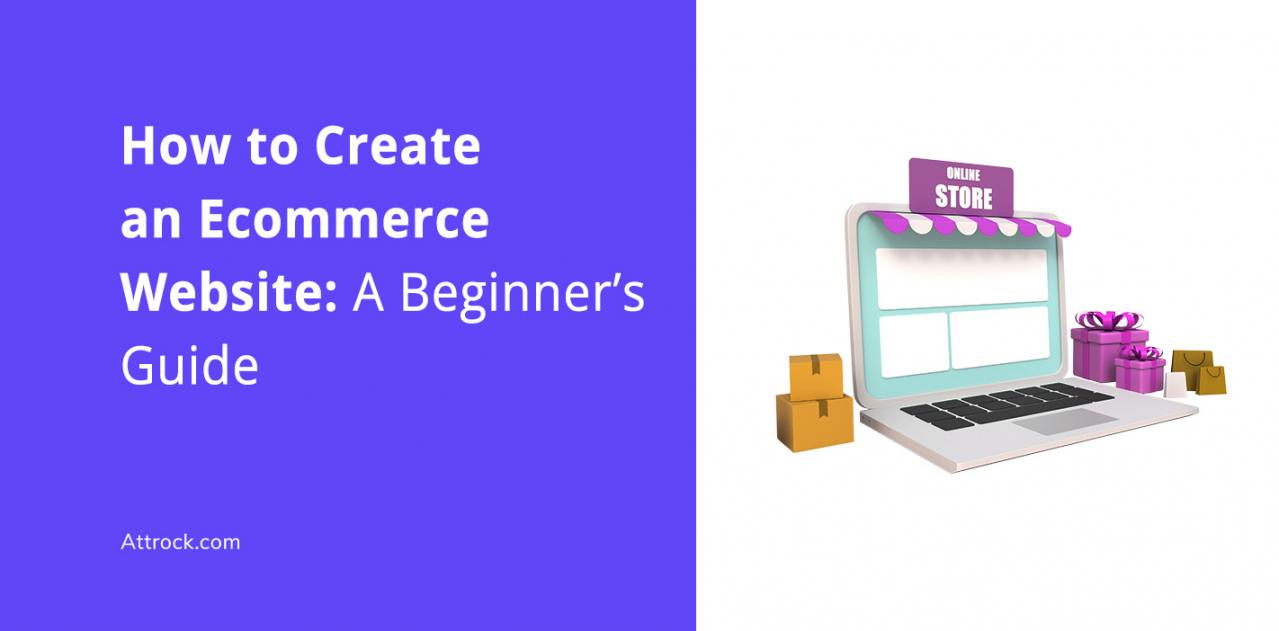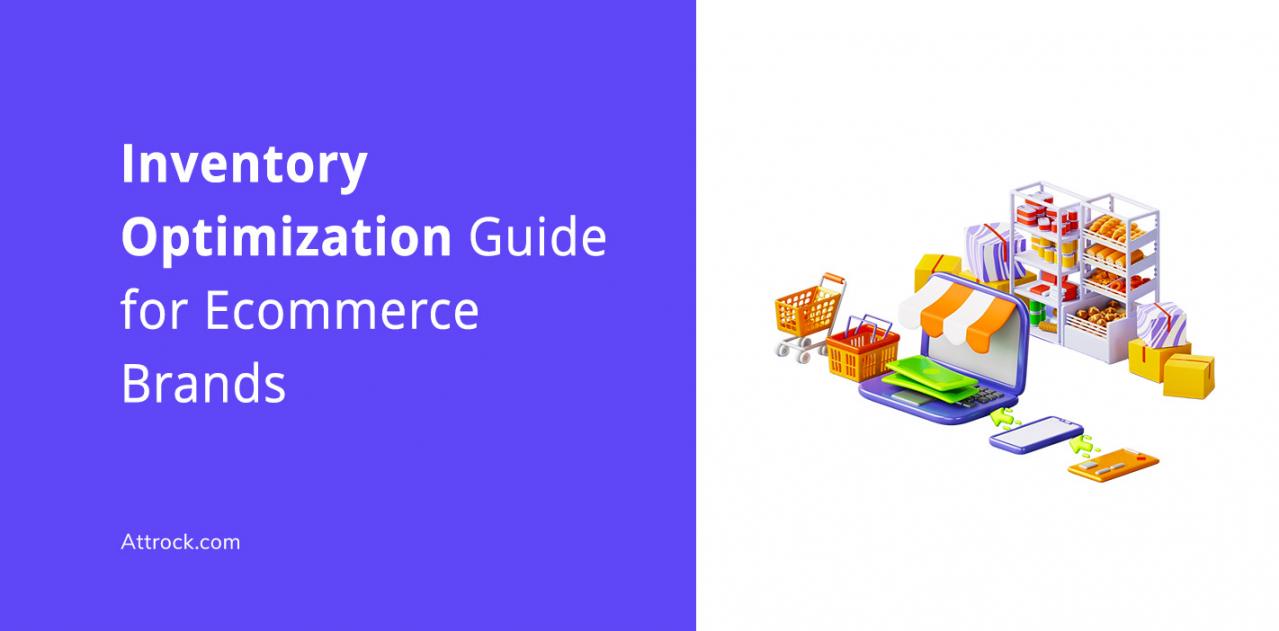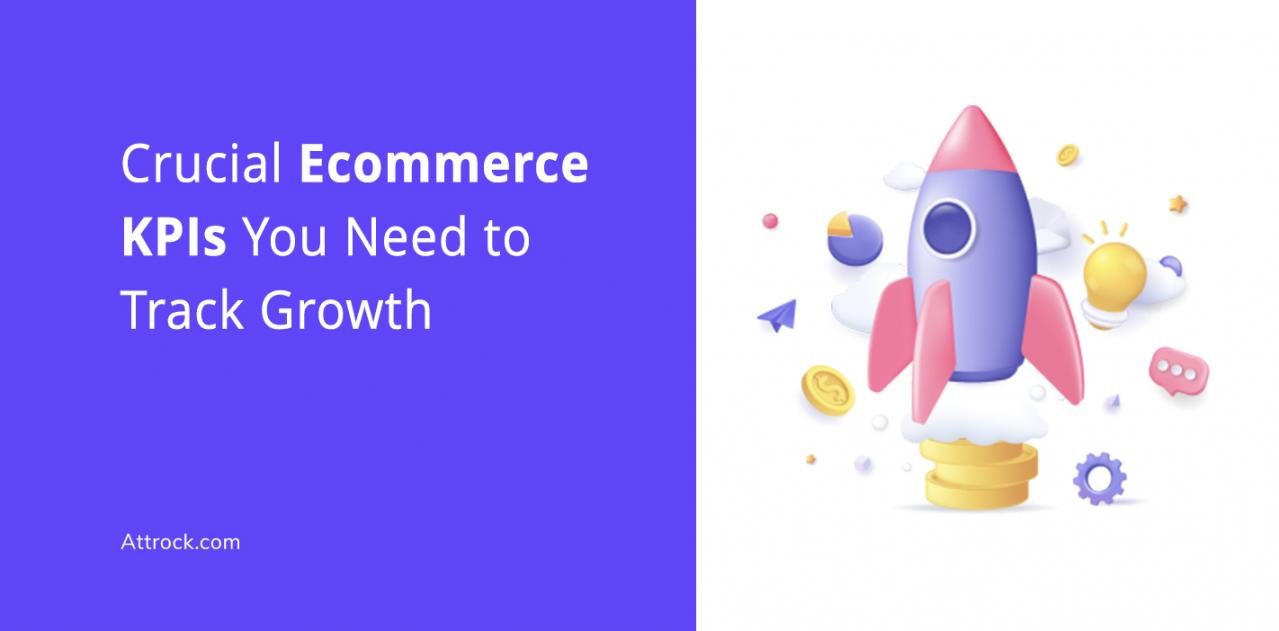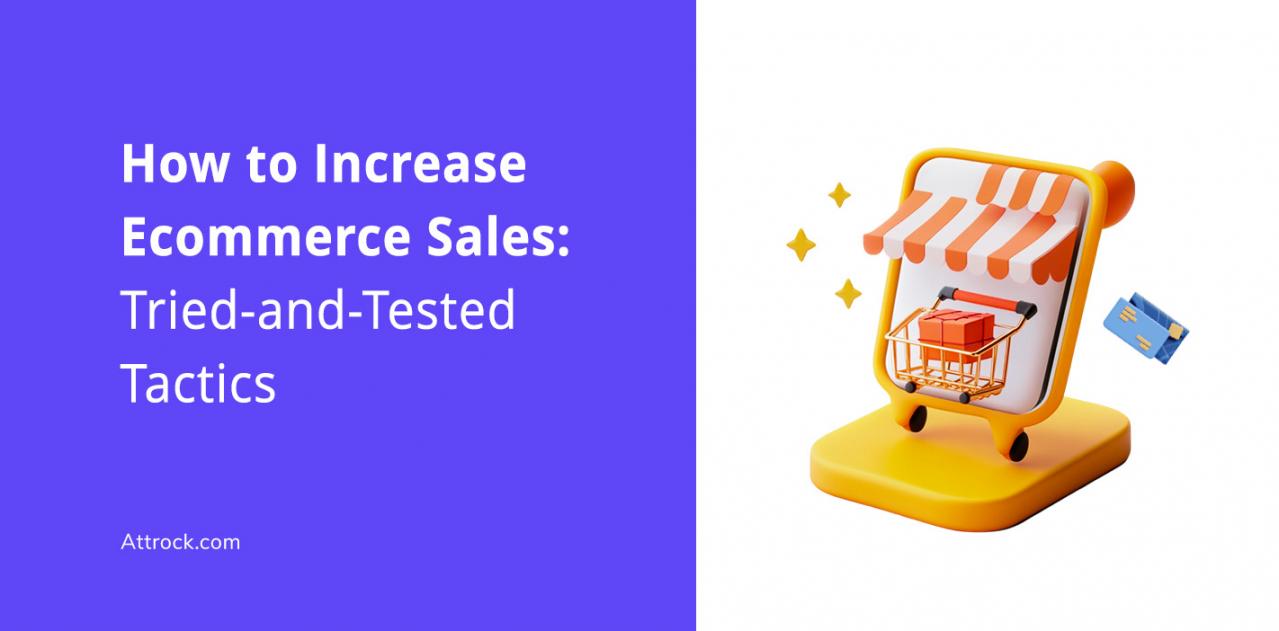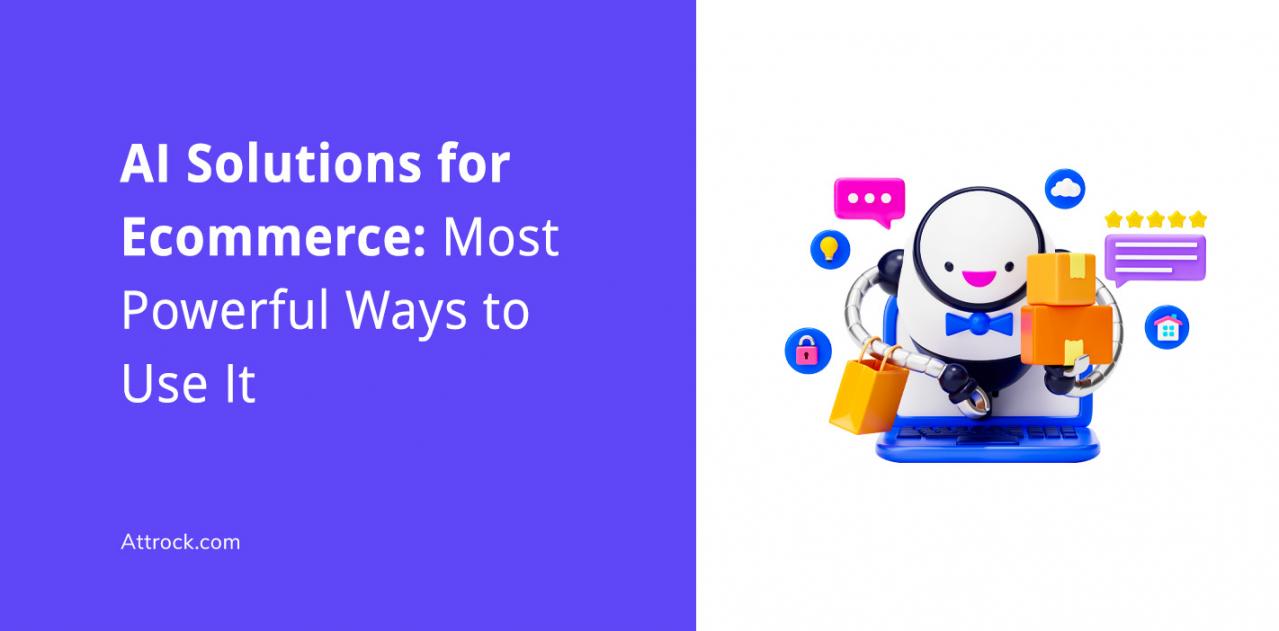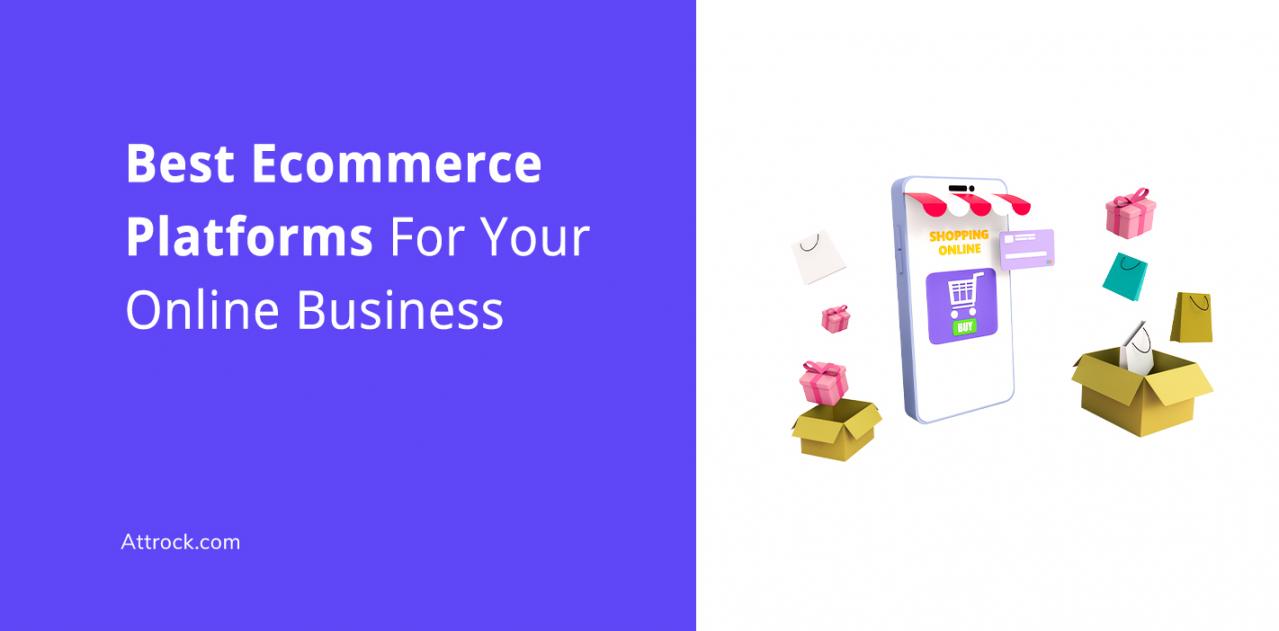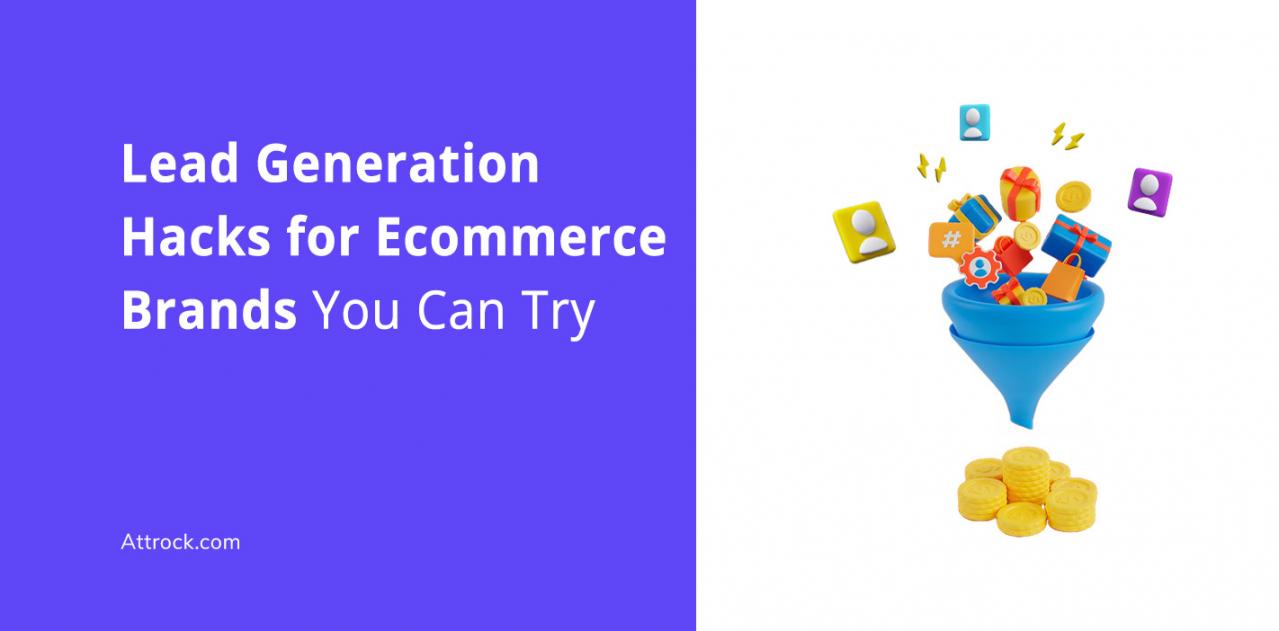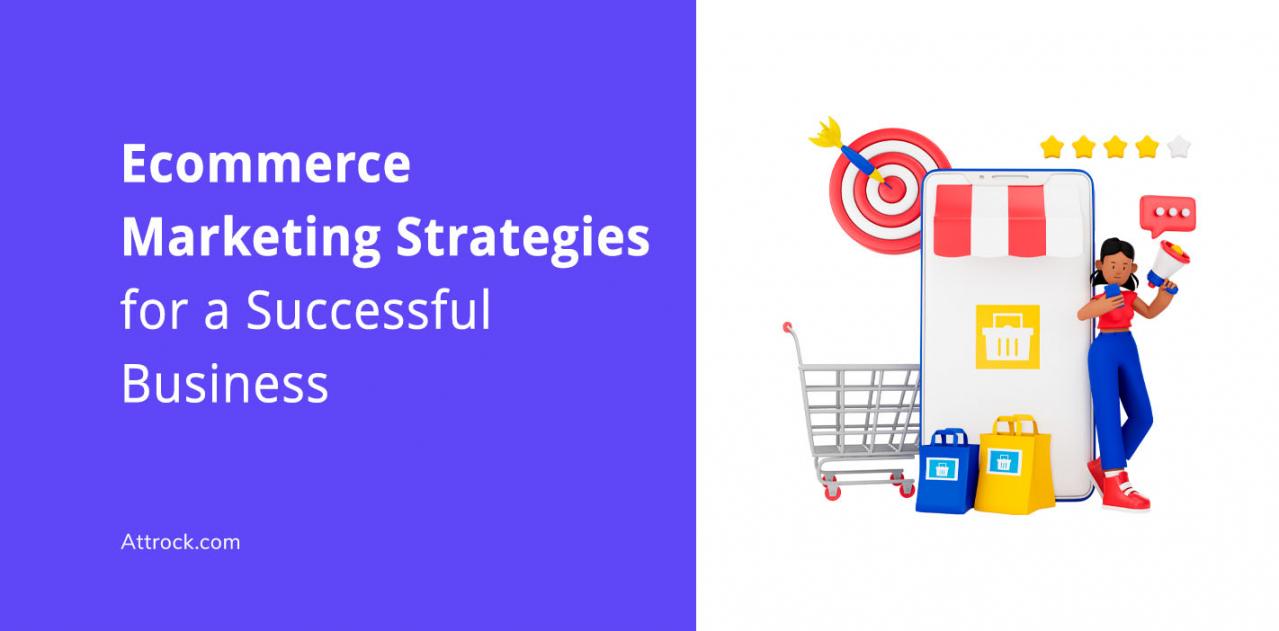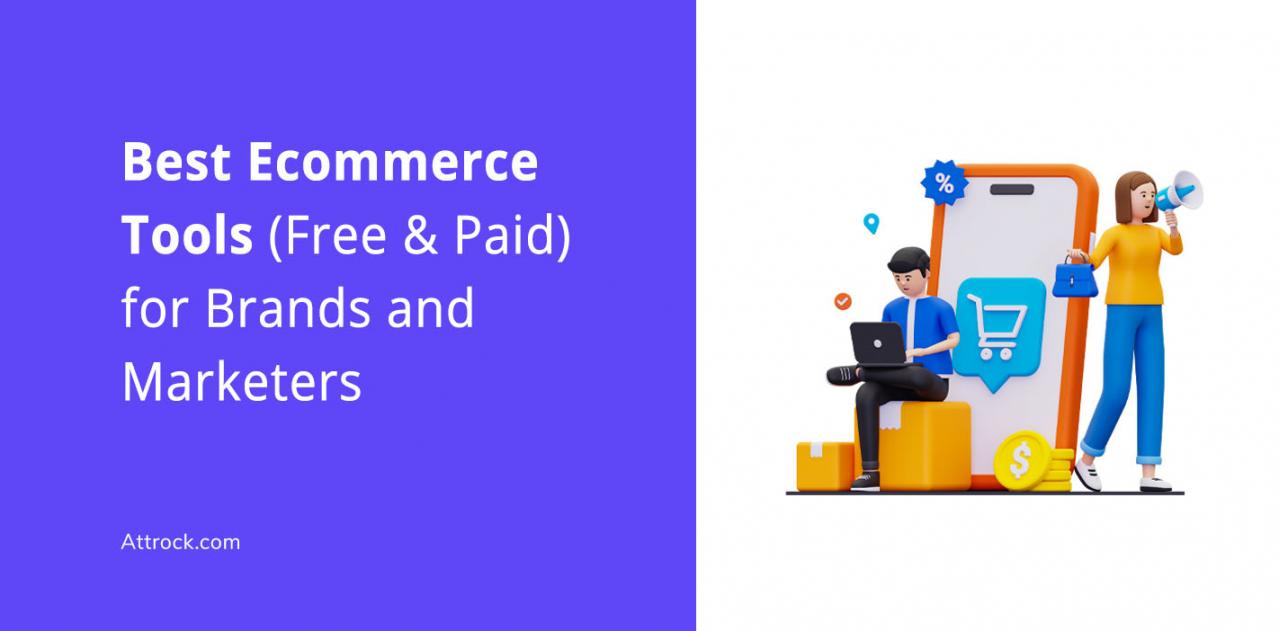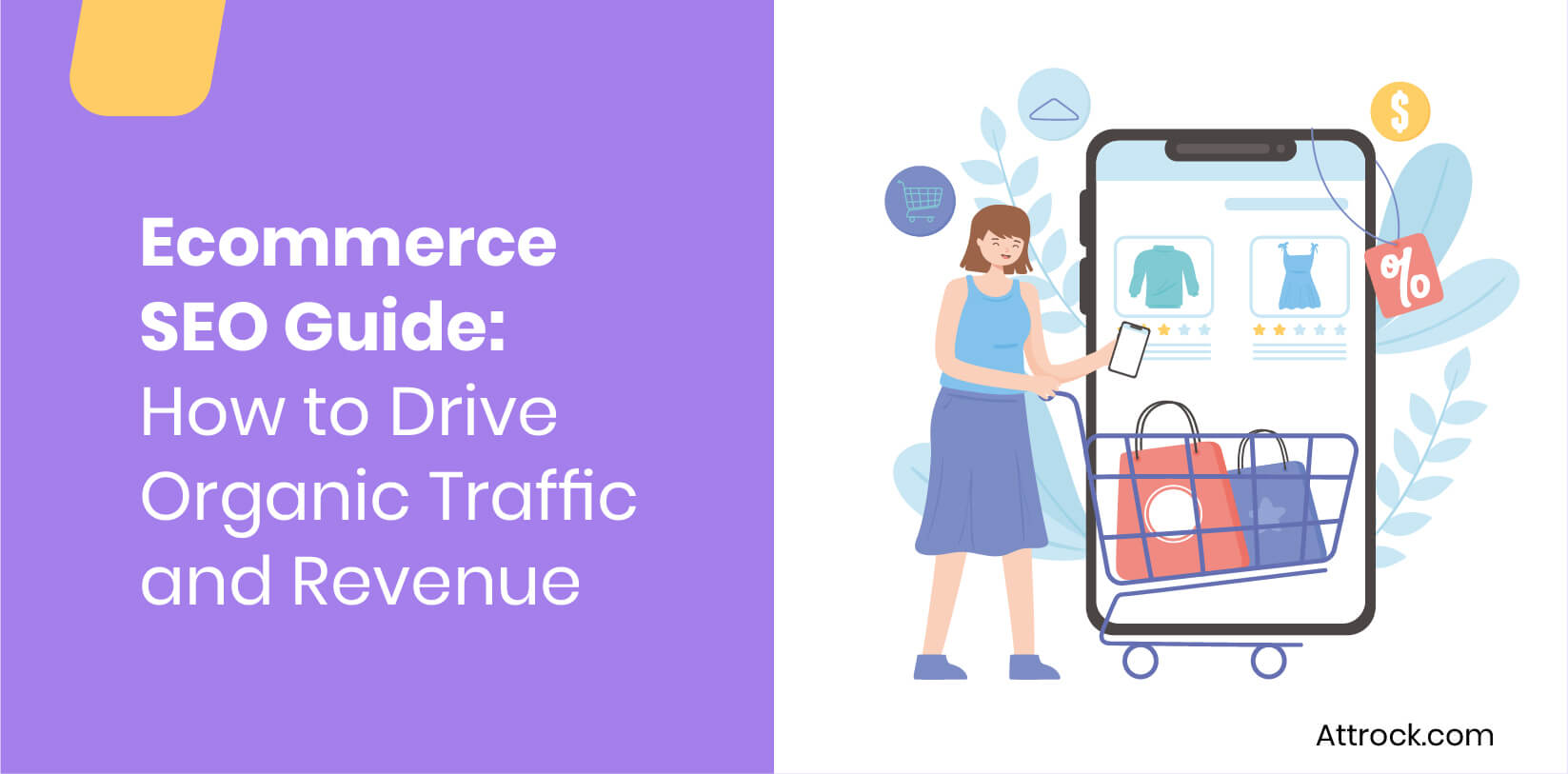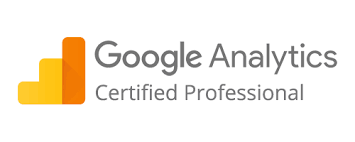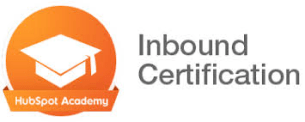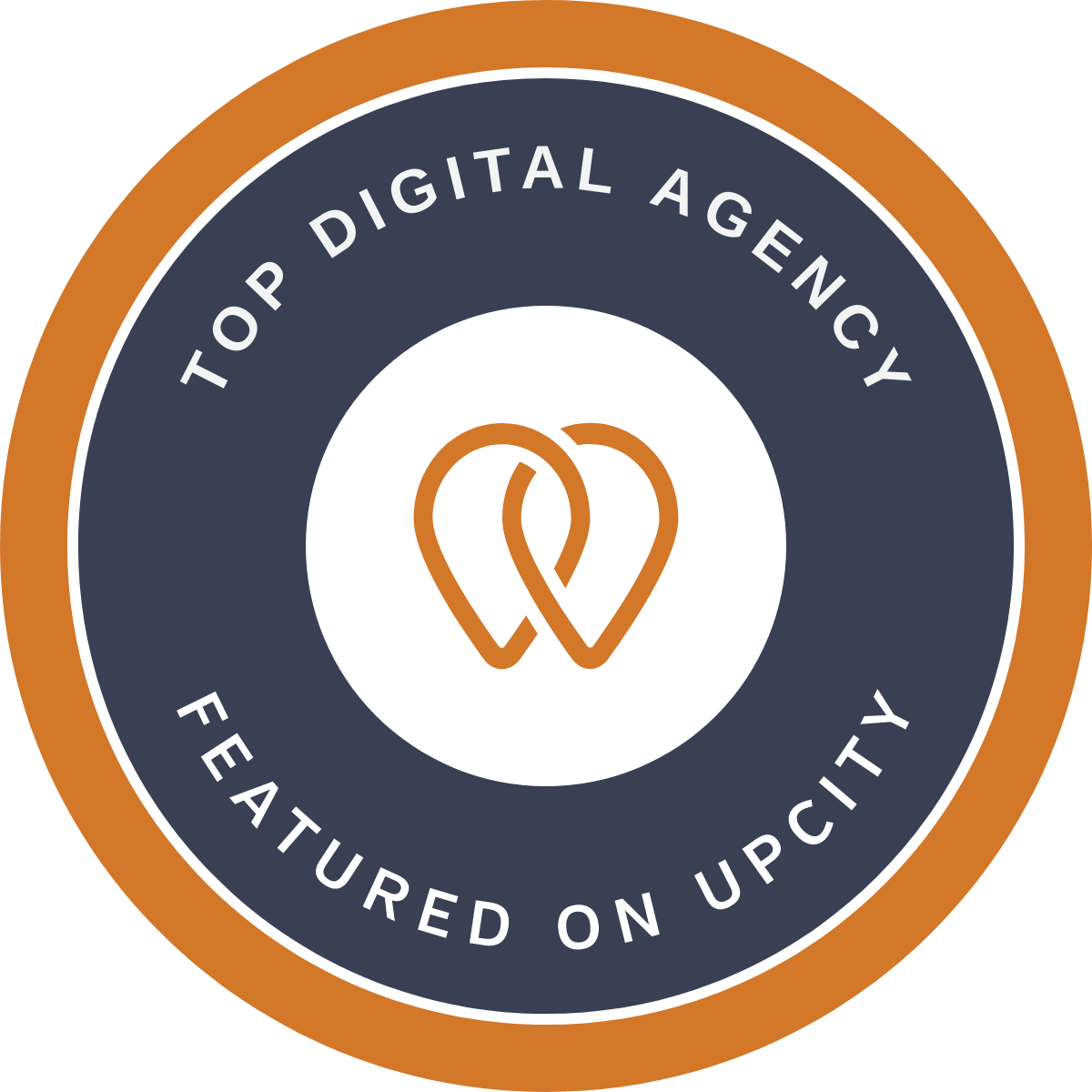Without a doubt, headless ecommerce platforms have revolutionized the way marketers do business today.
Gone are the days of using traditional ecommerce business models. More business owners have discovered the flexibility headless ecommerce platforms offer and are making the best out of them.
This is because headless commerce presents business owners with endless benefits. This business model allows you to scale your ecommerce business without compromising on quality.
So, are you considering leveraging headless ecommerce technology in 2025? If you are itching to join the headless ecommerce train, this article is for you.
We’ve compiled a list of 13 best headless ecommerce platforms to get you started. When it comes to flexibility, developer-friendliness, and scalability, the platforms on this list stand out.
Before we begin, let’s briefly discuss exactly what headless ecommerce platforms are and how they transform your business operations.
How We Chose the Best Headless Ecommerce Platforms
We compiled a comprehensive list of 13 best headless ecommerce platforms capable of catering to the needs of small and large business enterprises.
Here are the factors we used as a measuring yardstick for this list.
- Flexibility: As business trends evolve, the key to staying ahead is constantly updating your ecommerce marketing strategies. The best headless ecommerce platform should be able to adapt to changing market trends and consumer needs in a heartbeat.
- Developer-Friendliness: The headless ecommerce platforms we chose are equipped with advanced technology, providing back-end developers with a seamless and user-friendly experience. We ensured that their APIs were easy to use and developer-friendly.
- Scalability: As businesses evolve, so should their ecommerce models and business strategies. The best headless ecommerce platform should easily accommodate growth in transaction volumes and user bases. The platforms on this list are best for scalability and long-term business growth.
- Intuitive Front-End User Interface: The best headless ecommerce platforms should not only support user-friendly interfaces at the back end but also at the front end. Our list comprises headless ecommerce platforms that provide immersive, personalized user experiences to enhance customer satisfaction.
- Overall Performance: An ecommerce platform’s performance level directly influences user satisfaction and conversion rates. We selected the headless ecommerce platforms with fast loading times and the ability to handle many users while still providing a seamless shopping experience.
What are Headless Ecommerce Platforms?
The best headless ecommerce platforms are a type of architecture in which the front-end layer of an online store is decoupled from the back end. This allows ecommerce business owners to have more flexibility and creative freedom.
Although the front-end presentation of the platform remains separated from the back-end functionality, they are connected via application programming interfaces (APIs).
APIs serve as a communication channel between the digital touchpoints that customers interact with and the back-end ecommerce features like inventory optimization, checkouts, and payments. This is illustrated in the image below.
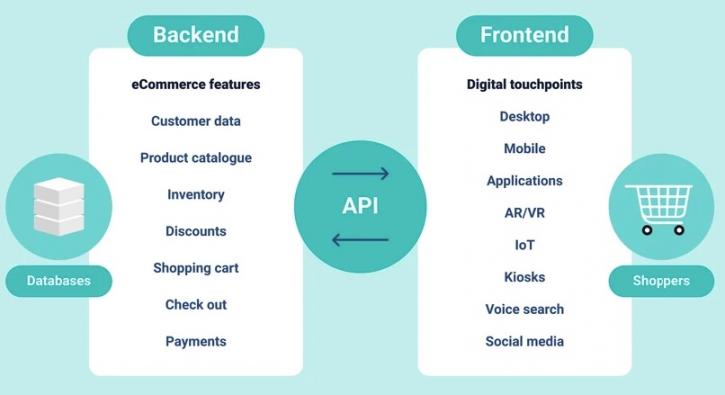
Image via Storyblok
Unlike traditional platforms, the best headless ecommerce platform allows you to create multiple front-end experiences without disrupting their functionality.
With this level of freedom, business owners can provide more personalized services to their customers across several touchpoints. This is more difficult to accomplish with traditional ecommerce platforms.
The best headless ecommerce platform provides marketers with multiple benefits, which include:
- System scalability
- Unlimited UX control
- Ease of integration
- Omnichannel experience
- Enhanced user experience
- Improved performance
- Faster time-to-market
All these benefits highlight why using the best headless ecommerce platform is the top choice for most marketers. Are you still wondering if you should make the switch from traditional ecommerce to headless ecommerce?
Let’s examine these two business models closely.
Traditional Ecommerce vs Headless Ecommerce
As of 2024, there were over 30 million active ecommerce stores worldwide and that number has been growing over the years as shown below.
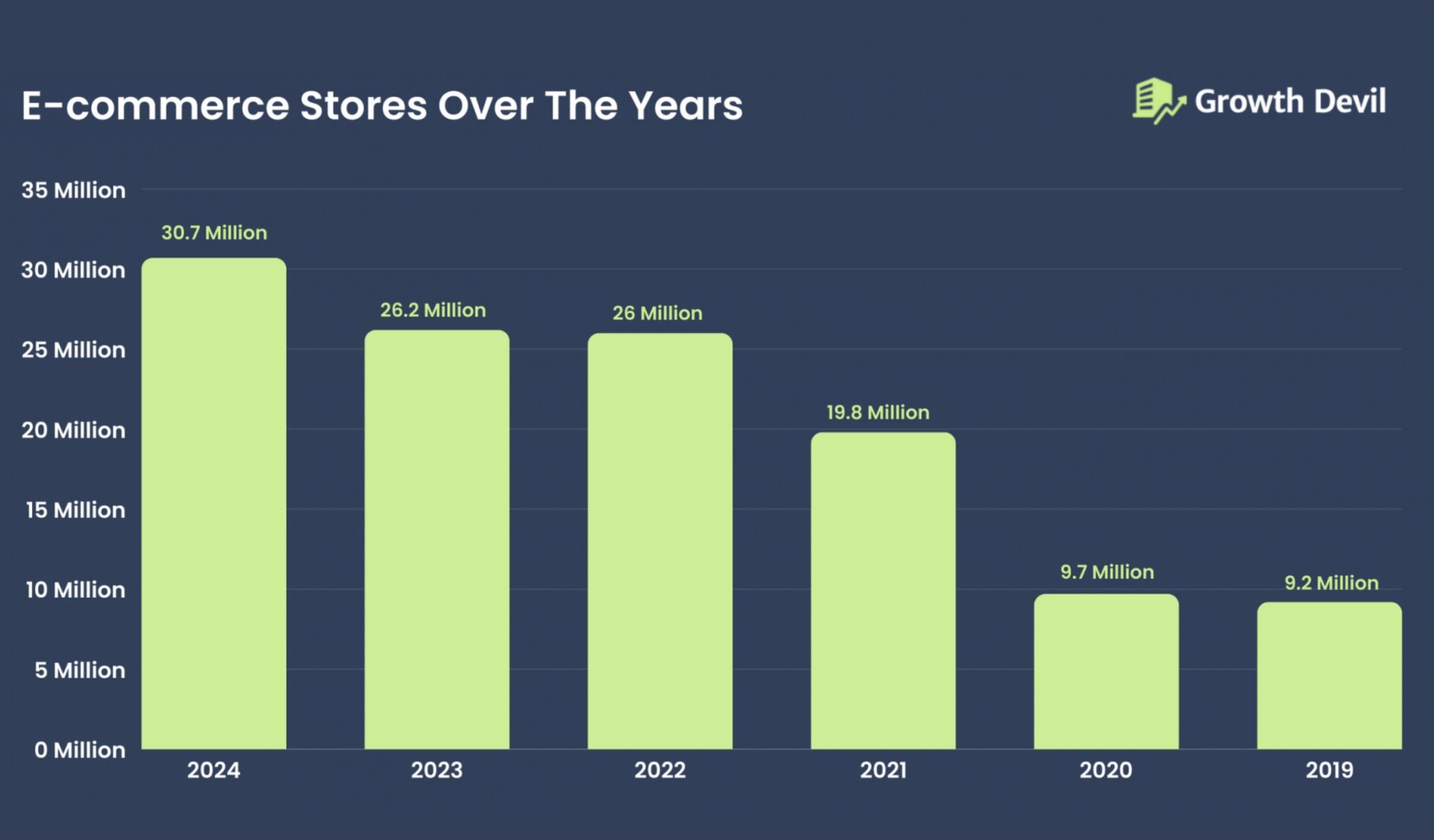
Image via Growth Devil
If you’re just starting your ecommerce business and are looking for quick ways to sell your product in the early stages, traditional ecommerce platforms are good options. They follow a traditional architecture with tightly integrated front-end and back-end architecture.
Alternatively, the best headless ecommerce platform becomes a good option when you’re looking to scale your ecommerce business and reach a wider customer base. Let's look at some core differences between these two business models.
Architecture
In the best headless ecommerce platform, the back and front ends are managed independently. This approach uses a separate technology stack, where the back end delivers data and functionality to the front end through APIs.
On the other hand, traditional ecommerce platforms operate as one entity with integrated functionalities. In this model, the back end controls the functionalities of the platform, as they are tightly linked. This is illustrated in the image below.
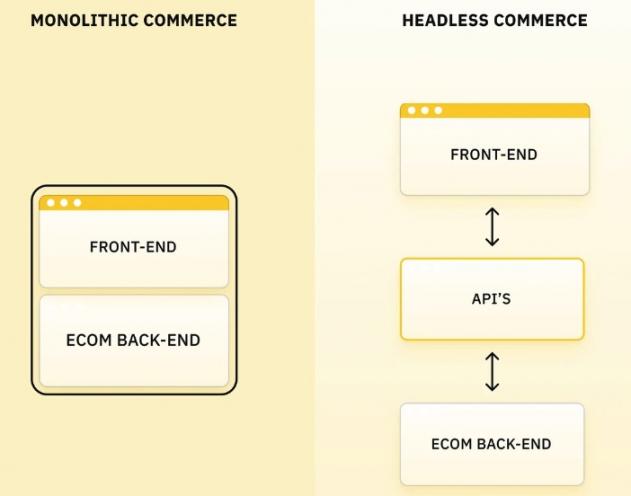
Image via Instant
Omnichannel Experience
Customers have a better shopping experience with the best headless ecommerce platform. This is irrespective of whether they’re using the web, mobile application, or other digital channels.
Due to the tightly integrated system of traditional ecommerce platforms, they are more suited for single-channel operations. So, with this model, your customers may get inconsistent experiences across multiple channels.
In contrast, the back-end APIs of The best headless ecommerce platform are designed to collaborate with multiple front-end applications. This allows you to create separate front ends tailored for various digital marketing channels, ensuring a seamless and consistent user experience across various devices.
The image below illustrates the different marketing channels that can be accessed with headless ecommerce platforms.

Image via WebDesk Solution
Performance and Speed
The coupled nature of monolithic platforms makes it difficult to make changes to the back end without affecting the front-end functionalities. Any changes made may slow down the system and reduce its performance.
Monolithic ecommerce platforms also have slower page load times, leading to a frustrating and unsatisfactory user experience.
With the best headless ecommerce platform, the back end and front end can be separately optimized without affecting performance. They use single-page application (SPA) technology to facilitate faster loading times and enhance user experience.
Customization
Traditional platforms provide limited flexibility and customization options, as most of them come with pre-designed templates. Modifying the design or adding more features may require extensive adjustments to the back end, which can disrupt the entire system.
The best headless ecommerce platform gives you more control over the user experience and allows you to customize the front end seamlessly. This makes it easy to make design changes and updates without affecting performance.
Now that you understand what sets the best headless ecommerce platforms apart from monolithic ones, you’re probably eager to jump in. But before you do, remember that the implementation of headless ecommerce requires some level of planning and strategizing.
With headless ecommerce, there’s no one-size-fits-all model. So, to reap the full benefits headless ecommerce platforms have to offer, you must select the best headless ecommerce platform that meets your unique business needs.
Now, how do you know what to look out for in the best headless ecommerce platform? Let’s explore that in the next section.
What to Look Out for in a Headless Ecommerce Platform
The best headless ecommerce platform should meet the demand for scalability, flexibility, and personalized user experiences.
The image below summarizes the features to look out for in headless ecommerce platforms.
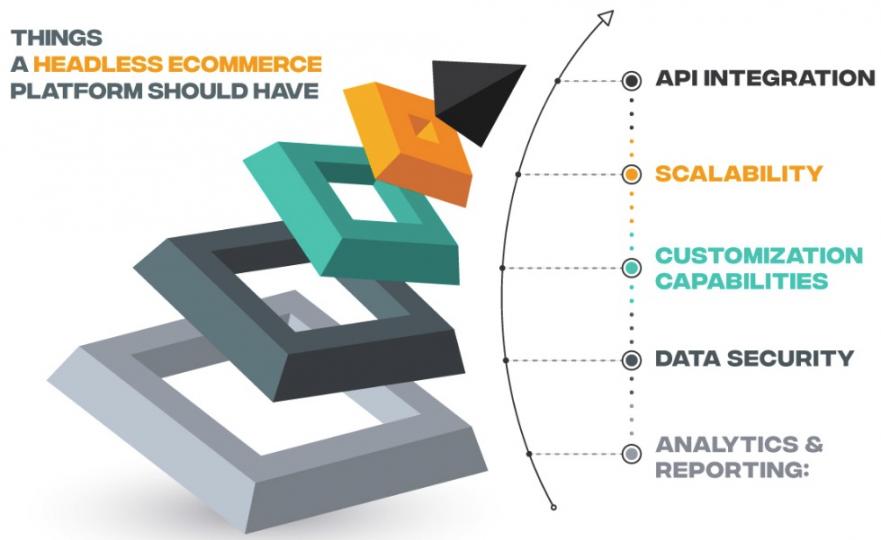
Image via OrangeMantra
Before you fully commit to headless ecommerce platforms, consider these factors and use them as a guide in making your decision. Let’s discuss some of these factors in detail.
What are its Integration Capabilities?
One of the key features that make the best headless ecommerce platform a popular option among marketers is its cohesive and integrated systems. But besides the integration between the front end and back end, it should also easily integrate with other business tools.
The best headless ecommerce platform should be able to connect to different marketing tools and third-party software without disrupting its basic framework.
For instance, the best headless ecommerce platform you choose should easily integrate with third-party analytics tools and CMS software.
These integration capabilities provided by the best headless ecommerce platform should enable you to gain sales insights. It should also track customer behavior, and monitor other valuable sales and marketing data.
Subsequently, you can use this information to make data-driven decisions and optimize your business for growth.
How Steep is the Learning Curve?
Headless ecommerce platforms are more complicated than traditional platforms, so they require more technical knowledge to navigate.
When choosing the best headless ecommerce platform, pick one that provides enough learning resources to help you use the platform and all its features.
A good platform should have easy-to-understand tutorial videos to walk you through the onboarding process. If you have any questions or difficulties navigating the platform, there should be easily accessible resources to guide you.
Does it Offer Good Customer Support?
Sometimes, even when the tutorial videos are easy to understand and the learning curve is short, you may still encounter technical difficulties.
That’s why choosing the best headless ecommerce platform is crucial—it should offer more than just informative tutorials. Look for a platform backed by a robust customer support team available through phone calls, texts, emails, or self-service options.
This way, if you ever experience any downtime in your online store, you have access to a team that will resolve the technical issues quickly. This can help you save time and money and improve customer retention.
How Well Does it Integrate with Payment Gateways?
After completing their shopping, the last thing your customers want to deal with is a cumbersome payment system.
Therefore, opt for the best headless ecommerce platform that seamlessly integrates with payment gateways like Stripe, Apple Pay, Square, and others, ensuring smooth and secure transactions.
The best headless ecommerce platform ensures payment gateways come equipped with essential security features.
To simplify the process for your customers, select a platform that offers diverse payment channels, including credit cards, debit cards, transfers, and mobile wallets.
This provides your customers with a wide range of options, enhancing their overall shopping experience.
Does it Have an Intuitive User Interface?
Switching to the best headless ecommerce platform comes with some upsides. For example, if your customers have a good experience navigating your online store, they’re more likely to return. Headless ecommerce platforms make the user journey fun, and interactive.
Ensure that the best headless ecommerce platform you select allows your goods or services to be neatly displayed in a clearly defined structure. Doing this makes it easier for customers to navigate the store and find what they’re searching for.
Moreover, the best headless ecommerce platform should support designs that include product descriptions, reviews, images, videos, and other resources. This enhances the look and feel of your store and further improves user experience.
13 Best Headless Ecommerce Platforms to Explore in 2025
Now that you know what to look for in the best headless ecommerce platform, why don’t you try one out and see what works for your business model?
We’ve compiled a comprehensive list of 13 best headless ecommerce platforms to guide your decision.
We’ve also included their key features, pros, cons, and other bits of information to give you a general overview of how the best headless ecommerce platforms work. Let’s get started.
1. Shopify Plus
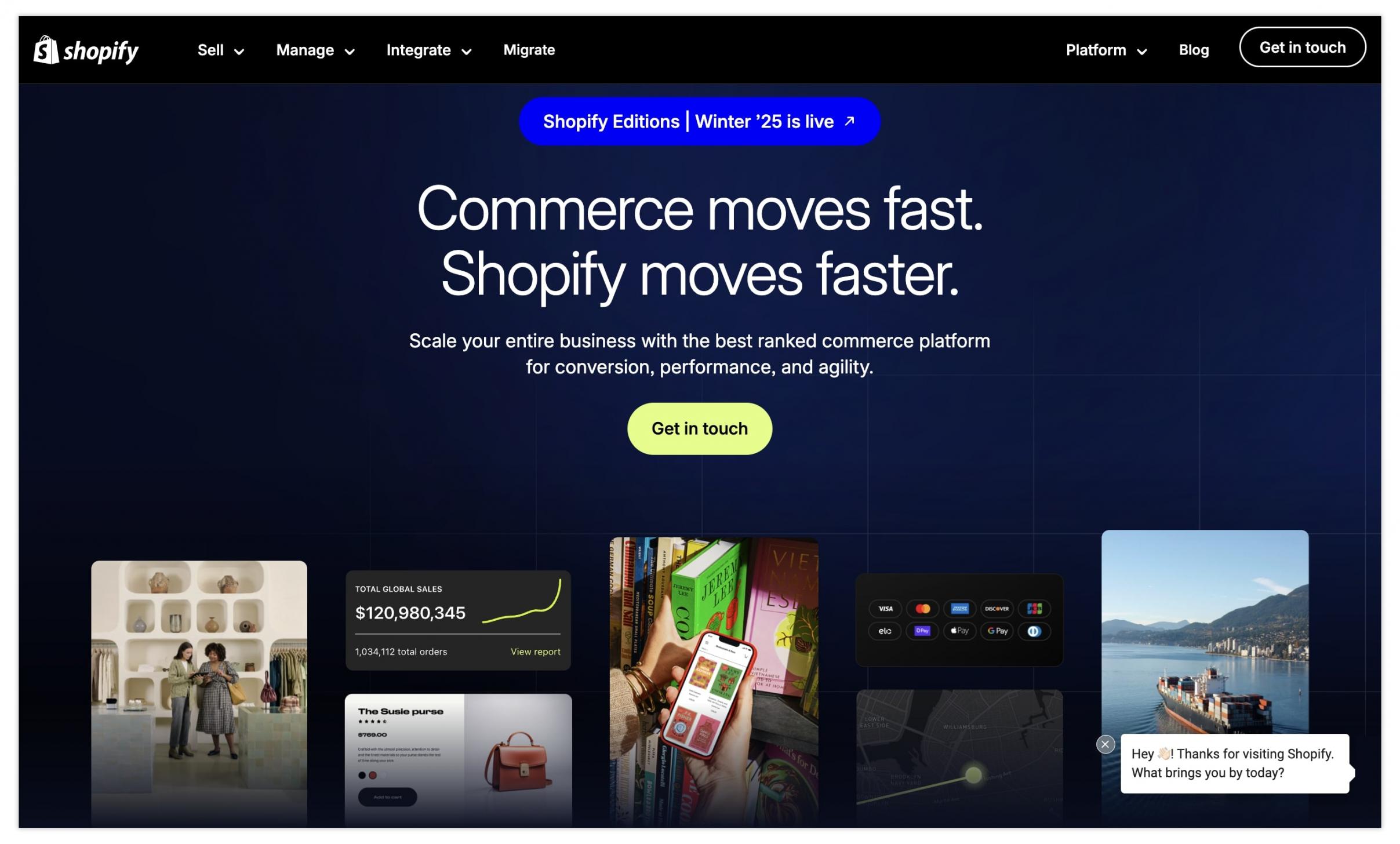
Image via Shopify Plus
Shopify is one of the most popular ecommerce platforms business owners around the world have relied on for years. It started as a traditional ecommerce platform and eventually introduced its headless commerce functionality under the name Shopify Plus.
Shopify Plus gives business owners complete creative control over their stores' front end, while it manages the back-end functionality.
As the best headless ecommerce platform, Shopify Plus is designed for small and medium-sized businesses and enterprises. So whether you have a startup or an established enterprise, you can grow it with Shopify Plus.
It is equipped with different features that allow you to customize your storefront with or without code.
For beginners, the platform offers built-in headless ecommerce solutions, while seasoned developers can further customize it to align with their business requirements.
So, what makes Shopify Plus one of the best headless ecommerce platforms out there? Take a look at its key features.
Key Features
- An extensive pool of seamless third-party integrations with CRM, ERP, PIM, and CMS tools.
- Robust GraphQL API resources for seamless storefront customization and other headless commerce functionalities.
- Numerous integrations with various tools, such as Wave, Slack, Airtable, Google Sheets, Stocky, and third-party marketplaces like eBay and Amazon.
- Access to Shopify Plus academy, which provides online training to guide you on ecommerce best practices.
- 99.99% online store uptime, with URL customization for SEO and higher visibility on Google SERPs.
- Customizable templates and themes for inventory management, discounts, checkout, and more.
Pros
- Built-in analytics tracking tools to gauge conversion rates and other sales data
- Level 1 PCI provides high financial security for both customers and business owners
- 24/7 customer service support via phone, live chat, and a resourceful help center
- User-friendly
Cons
- Limited design options
- High processing fees
- Limited access to plug-ins and add-on services on the low-tier plans
Pricing
- Shopify Plus pricing starts at $2,500 per month, but this is a variable fee that can be higher depending on the volume of business transactions.
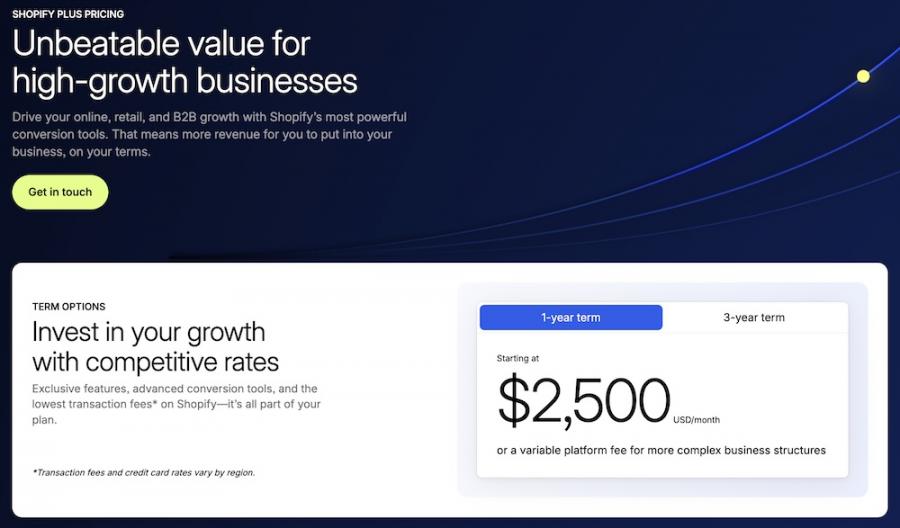
Image via Shopify Plus
Tool Level
- Intermediate
Usability
- Easy to use
Pro Tip: Use the rich integration capabilities of Shopify Plus to simplify your operations and reduce backlogs.
2. BigCommerce
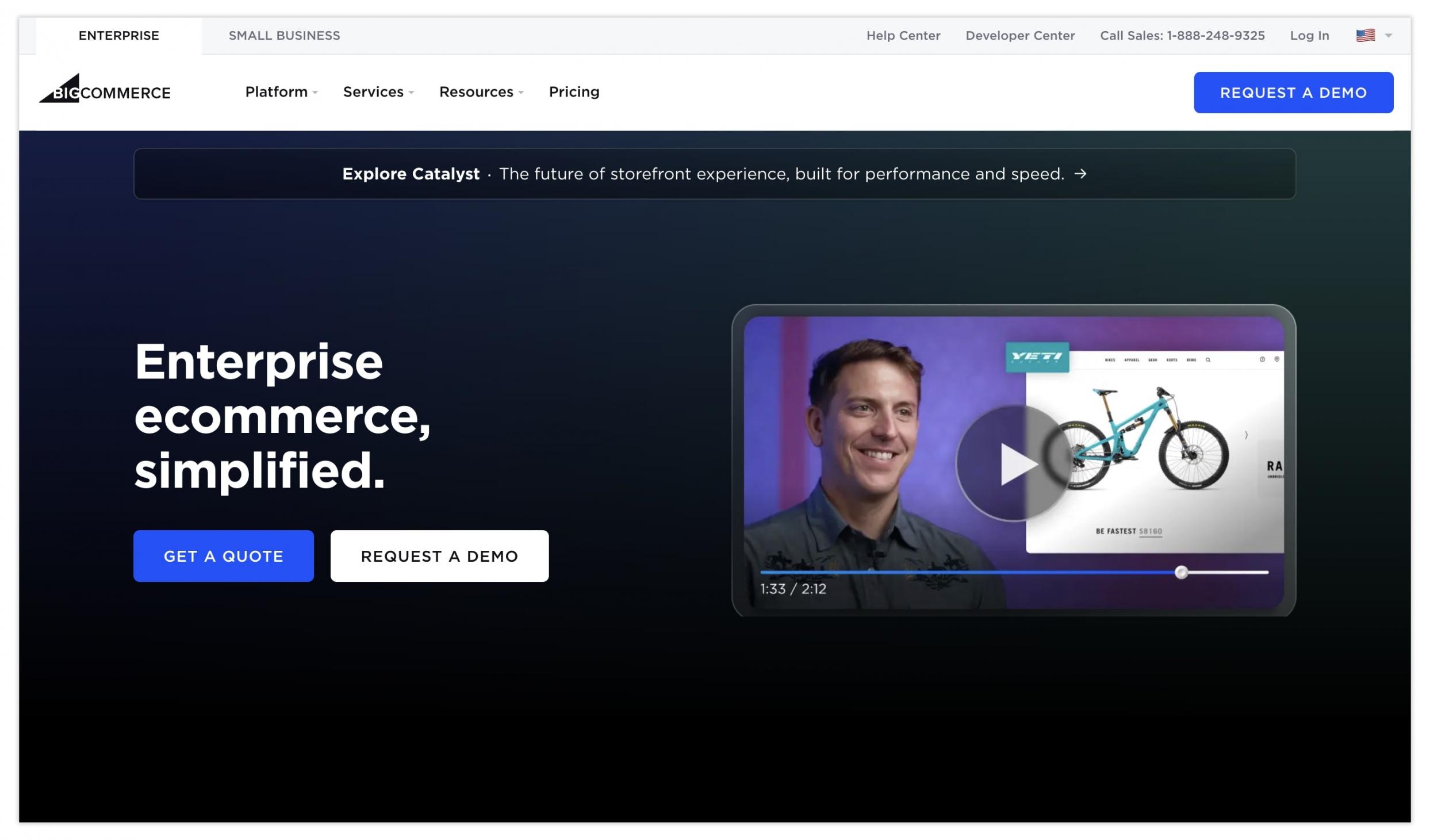
Image via BigCommerce
BigCommerce is one of the best headless ecommerce platforms. It offers an extensive range of business solutions for small businesses and large enterprises.
As a SaaS platform, it provides small businesses with everything they need to start a basic ecommerce site and scale when necessary.
One of the biggest advantages of using the best headless ecommerce platform like this is its API-driven system, which supports a wide range of third-party integrations. These integrations can be used for platforms like eBay, Amazon, Stripe, Drupal, and more.
A notable advantage that sets BigCommerce apart from some of the best headless ecommerce platforms on this list is its absence of API call throttling. So, regardless of your website traffic volume, your customers' API calls will receive timely responses.
Let’s consider some key features of this ecommerce platform.
Key Features
- Uses PayPal as its default payment gateway but also supports over 48 payment gateways, such as Stripe, Adyen, Apple Pay, and Google Pay.
- Supports multiple currencies and integrates with apps that feature a wide range of multilingual functionalities.
- Provides an extensive pool of built-in ecommerce functionalities like product management, inventory optimization and management, and order processing.
- Allows you to customize your storefront with 12 free design templates and 120 paid templates.
- Equipped with analytics and key reporting tools to track customer behavior and generate marketing reports.
- Allows you to manage multiple storefronts and go completely headless with its robust API functionalities.
Pros
- Does not charge transaction fees
- Affordable compared to most of the best headless ecommerce platforms
- 24/7 customer support via live chat, phone call, and email
- Supports multiple payment channels
Cons
- Does not include the abandoned cart feature in low-tier plans
- Limited customization options
Pricing
BigCommerce offers a 15-day free trial with four paid plans that offer various add-on benefits based on the tier.
- Standard: $39 per month
- Plus: $105 per month
- Pro: $399 per month
- Enterprise: Custom pricing
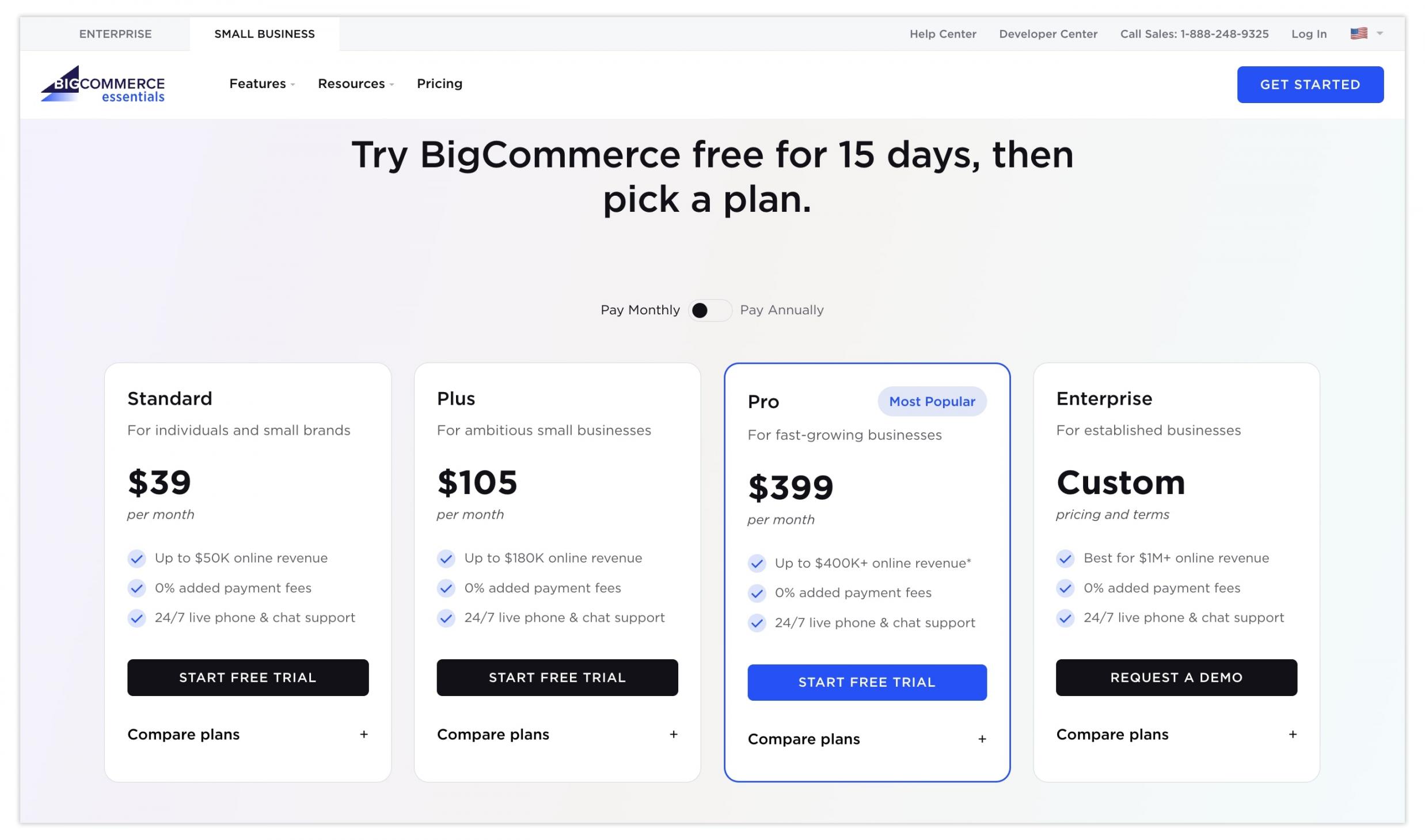
Image via BigCommerce
Tool Level
- Beginner
Usability
- Easy to use
Pro Tip: Leverage BigCommerce’s two-week trial to test-run its functionalities before you buy a paid plan.
3. Commercetools
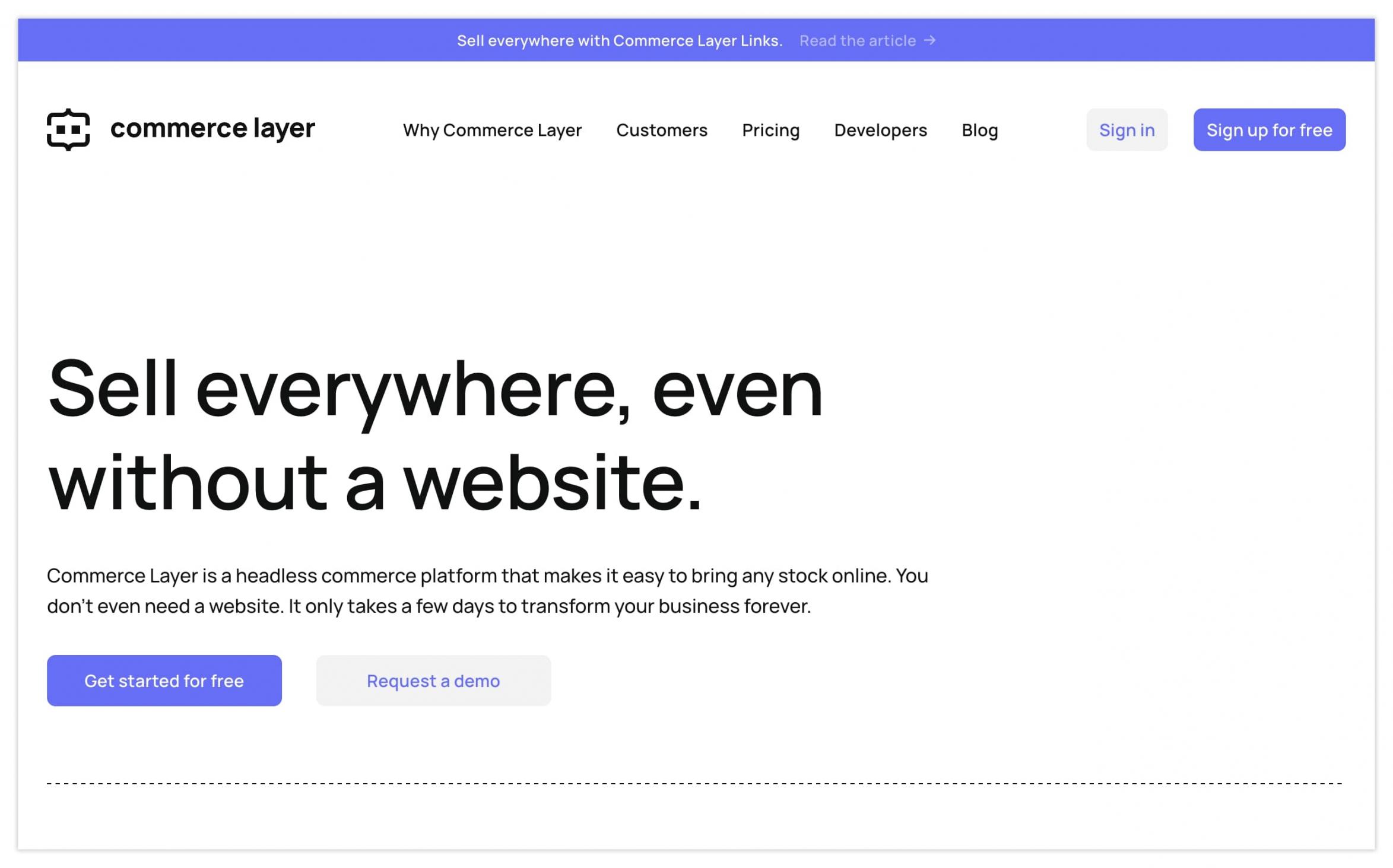
Image via Commercetools
Commercetools is an all-in-one business solution. It combines an API-first approach with microservices features and cloud-native architecture. This makes it the third best headless ecommerce platform on our list, perfect for businesses worldwide.
It is a SaaS platform that allows online business owners to build and customize unique digital storefronts across several consumer touchpoints.
So, if you’re looking for the best headless ecommerce platform to provide services via websites, VR applications, voice assistants, or social networks, Commercetools has got you covered.
With a capacity that spans over 300 API endpoints, Commercetools provides top-notch headless services for B2B and B2C companies. As one of the best headless ecommerce platforms, you won't need further customization using SQL because its APIs are capable enough.
Here are its key features, pros, cons, and pricing.
Key Features
- Features built-in tools for product information management (PIM), which helps users manage product-related data for more efficient marketing purposes.
- Enables third-party integrations with applications like Adyen, Frontastic, Bloomreach, Worldplay, Contentful, Contentstack, and more help desk.
- Provides customer support via live chat, email, help desks, FAQs forum, and calls.
- Its Merchant Center serves as a control panel to help business owners seamlessly manage retail operations and track orders.
- Provides training options via webinars and live videos to walk you through its onboarding process.
- Uses a multi-cloud infrastructure that supports cloud providers like AWS, GCP, and Azure, which help deliver reliable point-of-sale services.
Pros
- Offers a 60-day free trial with full access to all functionalities
- Microservices with flexible pricing options
- Consistent back-end functionalities with high uptime
Cons
- Difficult for beginners to use
Pricing
- Commercetools offers customized pricing plans based on your business needs and add-on microservices
Tool Level
- Intermediate
Usability
- Slightly difficult to use for beginners
Pro Tip: Commercetools has helpful webinars and live videos that you can use to learn how to navigate the platform for the best success.
4. OroCommerce
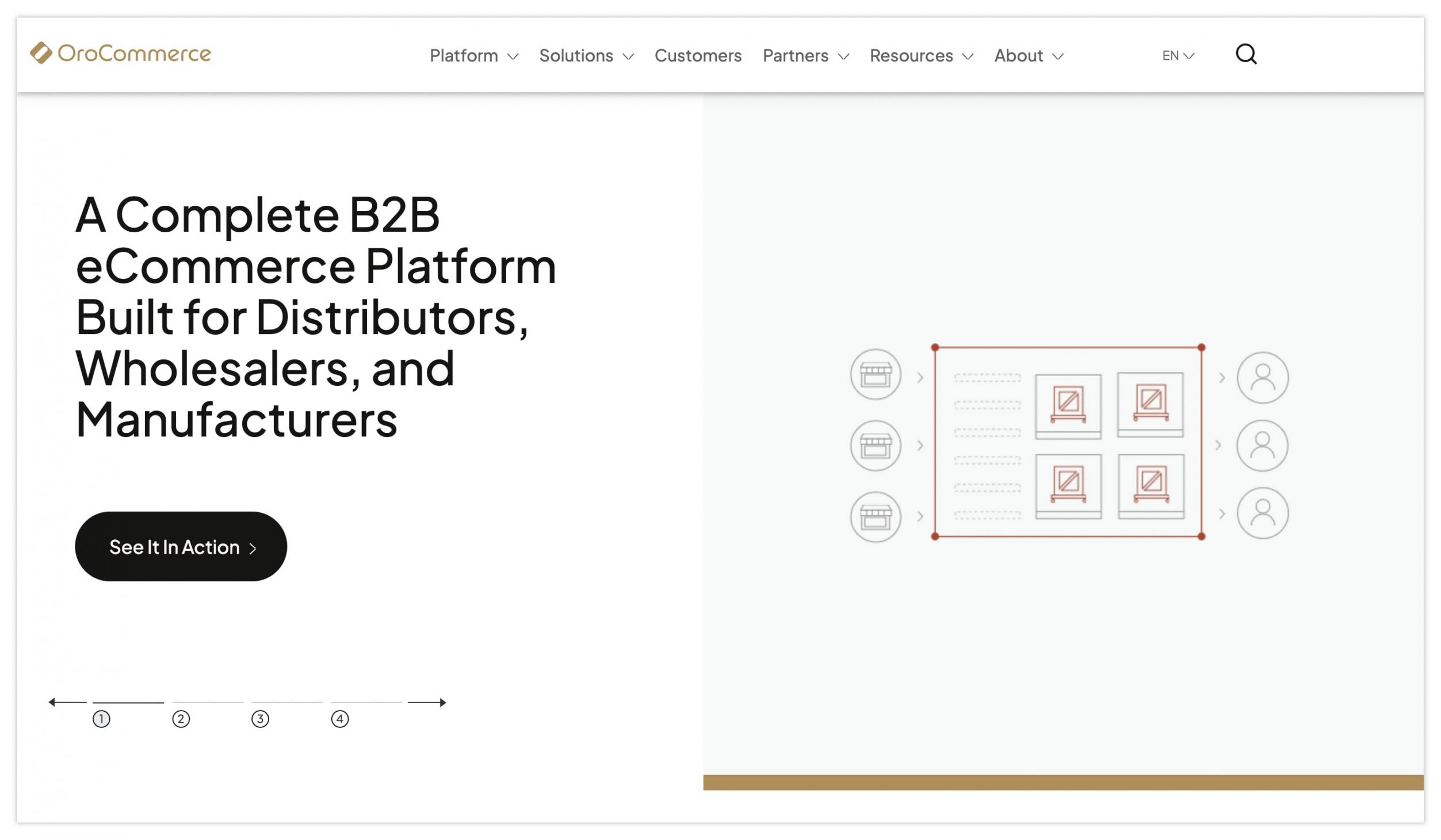
Image via OroCommerce
OroCommerce is one of the best headless ecommerce platforms that provides innovative business solutions for businesses across various sectors.
Although it caters mostly to B2B companies, its offerings can be customized to cater to B2C, B2C2C, and B2B2B business models. So, it’s suitable for medium to large businesses interested in both conventional and headless commerce architecture.
OroCommerce features in our best headless ecommerce platform list because it offers an extensive range of open-source ecommerce features. It can be used as a cloud-based software solution or with an on-premise set-up. This gives you the flexibility to decide how and where you want to run your storefront.
This platform also gives users the freedom to customize their front-end functionalities, while using cutting-edge APIs to provide a well-connected system. Here are its key features.
Key Features
- Allows PIM, ERP, EDI, and other third-party integrations, with the option of using its built-in OroCRM rather than opting for third-party CRM software.
- Features segmentation and reporting tools to track sales data and analyze customer behavior.
- Provides tools to help you create buyer-specific catalogs for customers, giving your customers a more personalized experience.
- Its inventory management features allow you to manage multiple storefronts, pricelists, and corporate customer accounts for a large consumer base.
- Robust API coverage suitable for scalability and long-term business growth.
- Provides customer support via phone, email, training courses, FAQ forums, and tickets.
Pros
- Account management features help streamline buyer-seller interaction
- Smooth third-party integrations
- Offers free enterprise demo and free community version
Cons
- Advanced open-source and B2B features may not be suitable for small businesses or startups
Pricing
- OroCommerce has custom pricing that you can request to receive a quote.
Tool Level
- Intermediate
Usability
- Easy to use
Pro Tip: You can use OroCommerce’s advanced tracking tools to monitor all your efforts so you can identify the strategies that work.
5. Elastic Path

Image via Elastic Path
Elastic Path is one of the best headless ecommerce platforms that help marketers deploy a range of headless solutions across several consumer touchpoints. It is an open-source software solution that provides microservices with robust API features.
This best headless ecommerce platform stands out among other headless ecommerce platforms because it helps streamline headless commerce operations across a wide range of industries. It caters to the needs of businesses in industries like healthcare, automotive, retail, and more.
Elastic Path provides APIs for seamless integration with a range of customization options. It offers integration with tools like PayPal, OpenAI, Avalara, Braintree, Card Connect, and GrapheneHC.
Whether you want to customize your digital storefront or manage subscription-based services, its API-based system is up to the task.
Take a look at the key features that make Elastic Path stand out among the best headless ecommerce platforms.
Key Features
- Leverages MACH architecture to provide API-based and cloud-native headless ecommerce solutions.
- Provides services based on composable architecture to make integrations with third-party applications easy.
- Seamlessly integrates with POS, ERP, and CRM systems.
- Utilizes a catalog composer to provide an easy way for users to create, customize, and manage multiple catalogs.
- Features a built-in product information management (PIM) system to enhance merchandising and product marketing across all consumer touchpoints.
- Flexible deployment options that let you operate your storefront as a cloud-based or on-premise system.
Pros
- 24/7 responsive customer support team
- Flexible pricing compared to other best headless ecommerce platforms on this list
- A 14-day Free trial
Cons
- May be too advanced for small businesses and startups
Pricing
Elastic Path offers a 14-day free trial and three paid plans with custom pricing based on your business requirements.
- Free Trial: $0 for 14 days
- Product Experience Manager: Custom pricing
- Commerce Essentials: Custom pricing
- Elastic Path Composable Commerce: Custom pricing
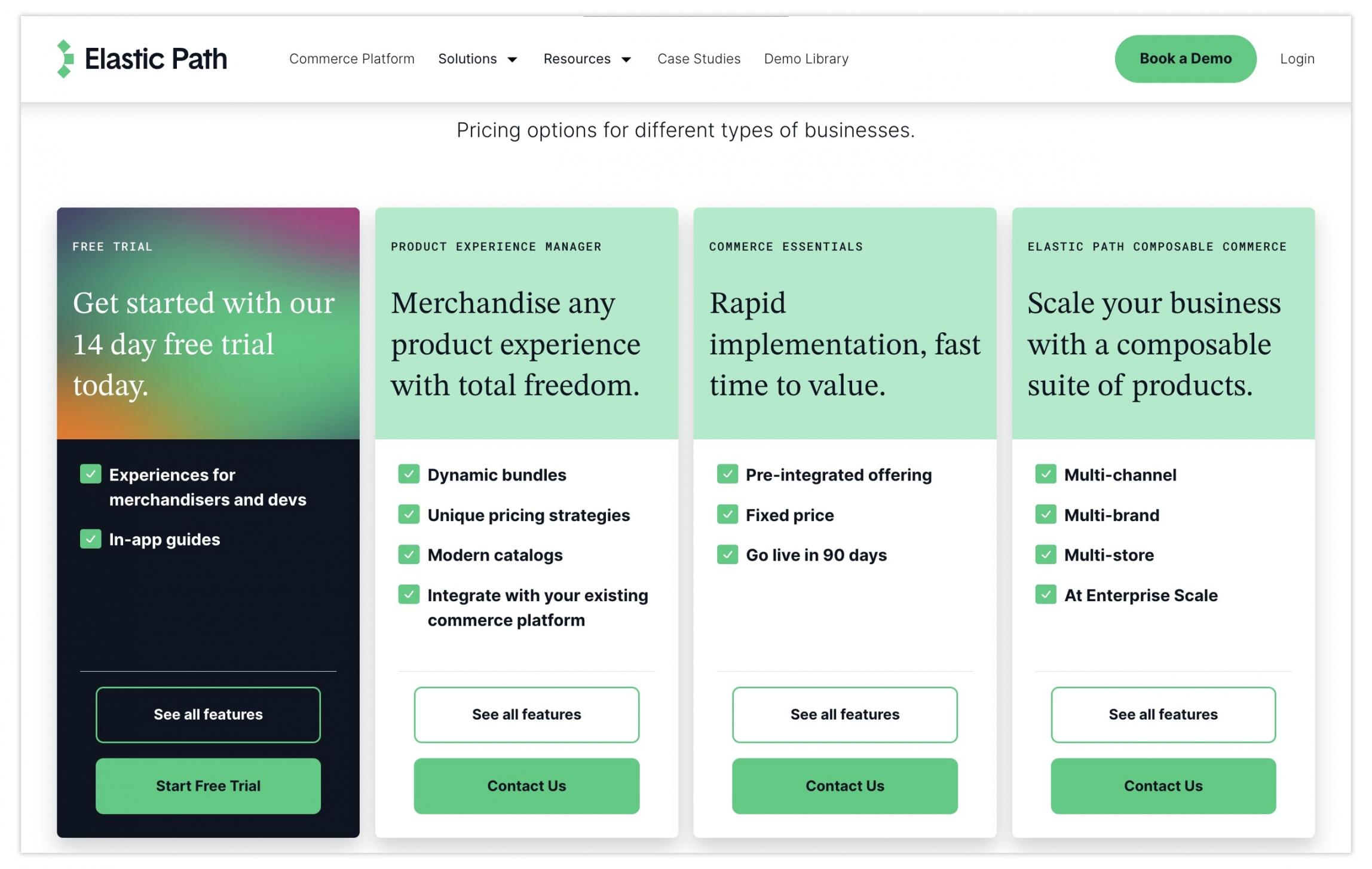
Image via Elastic Path
Tool Level
- Intermediate
Usability
- Moderately easy to use
Pro Tip: Use Elastic Path’s ability to seamlessly integrate with major payment platforms like PayPal to provide user-friendly payment options.
6. Spryker
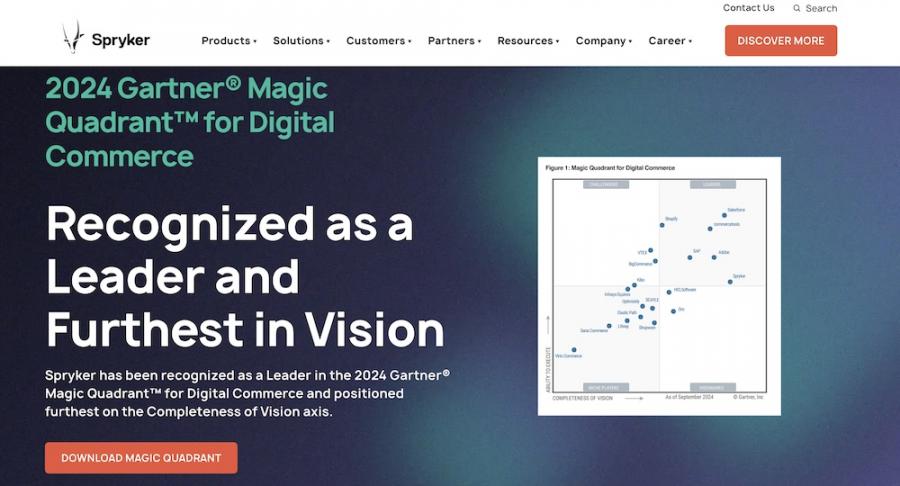
Image via Spryker
Spryker is a Berlin-based best headless ecommerce platform that provides innovative ecommerce solutions for B2B and B2C companies alike.
With a robust selection of about 900 API modules, Spryker makes it easy for businesses to separate the front end of their commerce applications from the back end.
It provides reliable cloud-based services to help you customize and create unique storefronts without technical limitations. Besides customization options, it also streamlines business operations with features like inventory management, product catalogs, discount management, and more.
As one of the best headless ecommerce platforms, Spryker prioritizes seamless integration with third-party applications like RatePay, Nitrobox, PayPal, Adyen, and Paysafe. Let’s explore its key features below.
Key Features
- Provides customizable store-front templates with headers, footers, homepage, and other predefined website sections.
- Allows you to monitor customer behavior and track sales insights using an easily accessible activity dashboard.
- Provides training options via videos, documentation, and a headless ecommerce master class to guide you through a seamless implementation.
- Features order tracking, inventory management, wish lists, ratings, product data management, and other functionalities to streamline business operations.
- Uses a modular headless ecommerce architecture that allows business owners to configure the components according to their business requirements.
- Allows developers to extend its functionality using modules and plugins.
Pros
- This headless platform Provides an extensive range of third-party integrations
- Fast deployment
- Tight data security
Cons
- May be too advanced for small businesses and startups
Pricing
- Spryker offers a free demo version and custom pricing on request
Tool Level
- Intermediate
Usability
- Moderately easy to use
Pro Tip: Use Spryker’s advanced tracking capabilities to track customer behaviors, anticipate their next moves and adjust accordingly.
7. Salesforce Commerce Cloud

Image via Salesforce
Powered by leading CRM software provider Salesforce, Salesforce Commerce Cloud is one of the best headless ecommerce platforms you can try in 2025.
The platform’s user-friendly features are suitable for creating and customizing unique storefronts based on your business needs. Its cloud-based capabilities allow you to launch your new ecommerce site within a short time.
One of the key features that put Salesforce in our best headless ecommerce platform list is its innovative AI-powered commerce capabilities. It’s more advanced than most of the other headless ecommerce platforms.
You can leverage its generative AI to carry out predictive analysis and recommend personalized content to your customers. This enhances customer satisfaction, keeping you one step ahead of the competition at all times.
What other functionalities make Salesforce Commerce Cloud one of the best headless ecommerce platforms? Take a look at its key features.
Key Features
- Enables multi-site coverage and localization, allowing you to customize your storefront based on the specific requirements of the country in which your business operates.
- Supports a range of third-party integrations with platforms like LinkedIn, Twitter, Slack, Amazon, NetSuite, and more.
- Integrates with Salesforce’s customer relationship management software solution for further customization.
- Provides a unified commerce experience with tools for customer acquisition, reporting and analytics, order management, and payments.
- Automated order processing to provide quick and efficient service to your customers.
- Integrates with several payment gateways to enable business owners to accept payments in over 130 currencies.
Pros
- Consistent customer support system
- Uses AI and automation to enhance business operations
- Integrated CRM functionalities
Cons
- It’s not beginner-friendly
Pricing
Salesforce Commerce Cloud customizes pricing plans according to the volume of your business transactions. It has three paid plans, which include:
- Starter Suite: $25 per user per month
- Pro Suite: $100 per user per month
- Commerce Cloud: Pay-As-You-Go
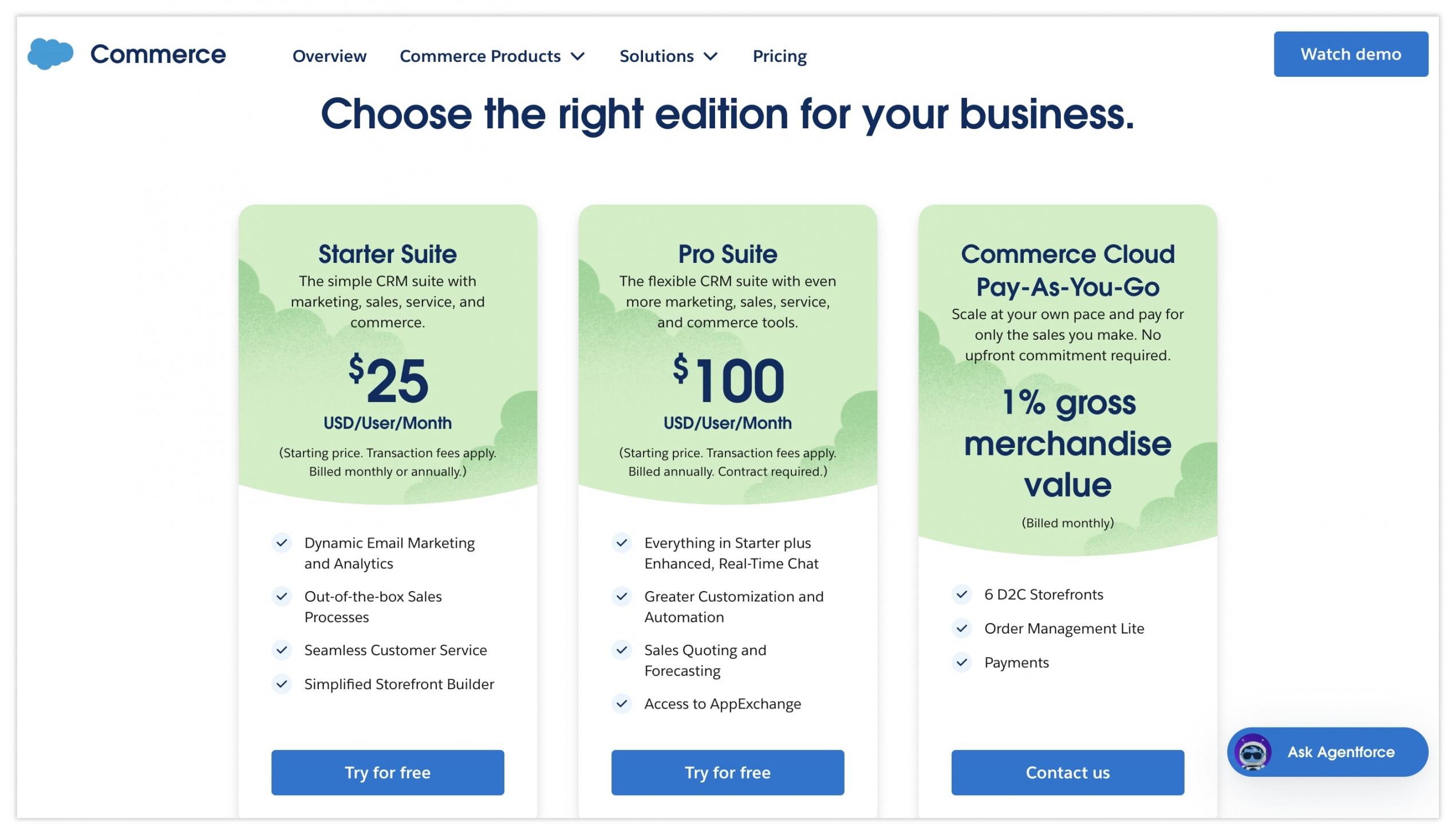
Image via Salesforce
Tool Level
- Intermediate
Usability
- Easy to use
Pro Tip: Link Salesforce Commerce Cloud with other Salesforce-related systems for seamless functionality.
8. Swell
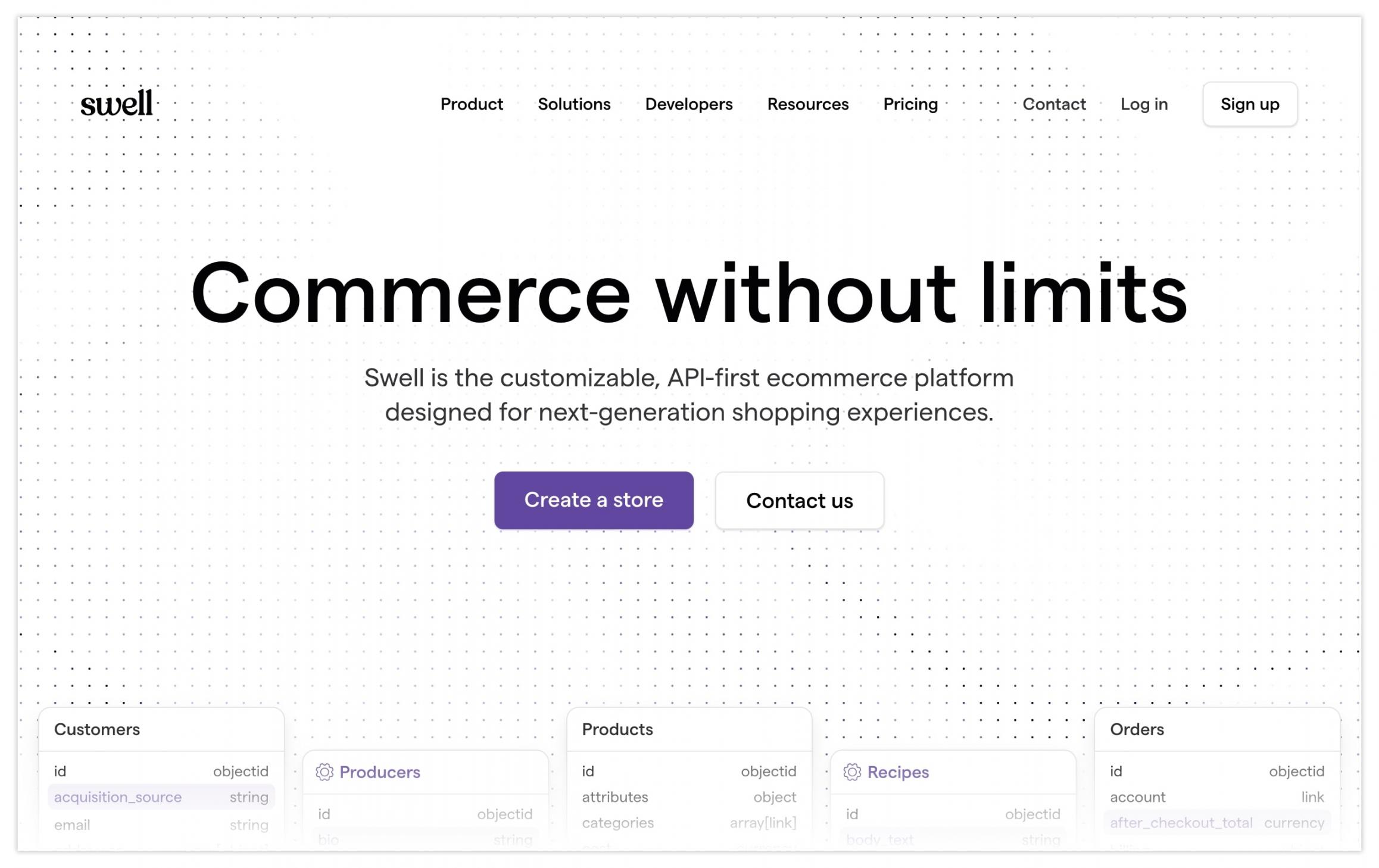
Image via Swell
Swell is an API-first ecommerce platform and one of the best headless ecommerce platforms. It provides flexible and scalable headless ecommerce solutions to B2B and B2C companies.
Its decoupled architecture allows business owners to customize and update their front-end architecture without compromising the back-end functionalities. Even on its free plan, it offers full API access to enable you to scale your ecommerce business.
Swell’s customization features deliver unique user experiences across various digital channels like web, mobile, and VR/AR technology touchpoints. Even if you’re not a seasoned developer, you’ll find Swell’s interface easy to use as it doesn’t require coding.
If you’re looking for the best headless ecommerce platform with more advanced features, Swell has you covered. It offers unlimited scalability and advanced integration options with its high-tier plans. Take a look at its key features.
Key Features
- Gives you multiple storefront access using one account, with opportunities for collaboration with other users.
- Provides a pre-designed theme with out-of-the-box design capabilities to enable you to customize your storefront.
- Features a centralized dashboard where you can access sales reports, customer behavior metrics, and finance trends.
- Allows you to create recurring orders for subscription-based products and services.
- Supports currency toggling which enables you to easily accept payments from international customers.
- Integrates with payment gateways like Stripe, Braintree, PayPal, Apple Pay, Worldplay, Klarna, and others.
Pros
- Offers a free forever plan
- Supports multi-currency transactions
- Provides abandoned cart recovery features
Cons
- Limited customer service options on the free plan
- Limited pre-designed storefront themes
Pricing
Swell offers a free forever plan with limited access to functionalities, and it also offers tiered paid plans.
- Starter Plan: $19 per month
- Basic Plan: $89 per month, for up to five admin users
- Standard Plan: $299 per month, for up to 15 admin users
- Unlimited Plan: $2,000 per month, for unlimited users
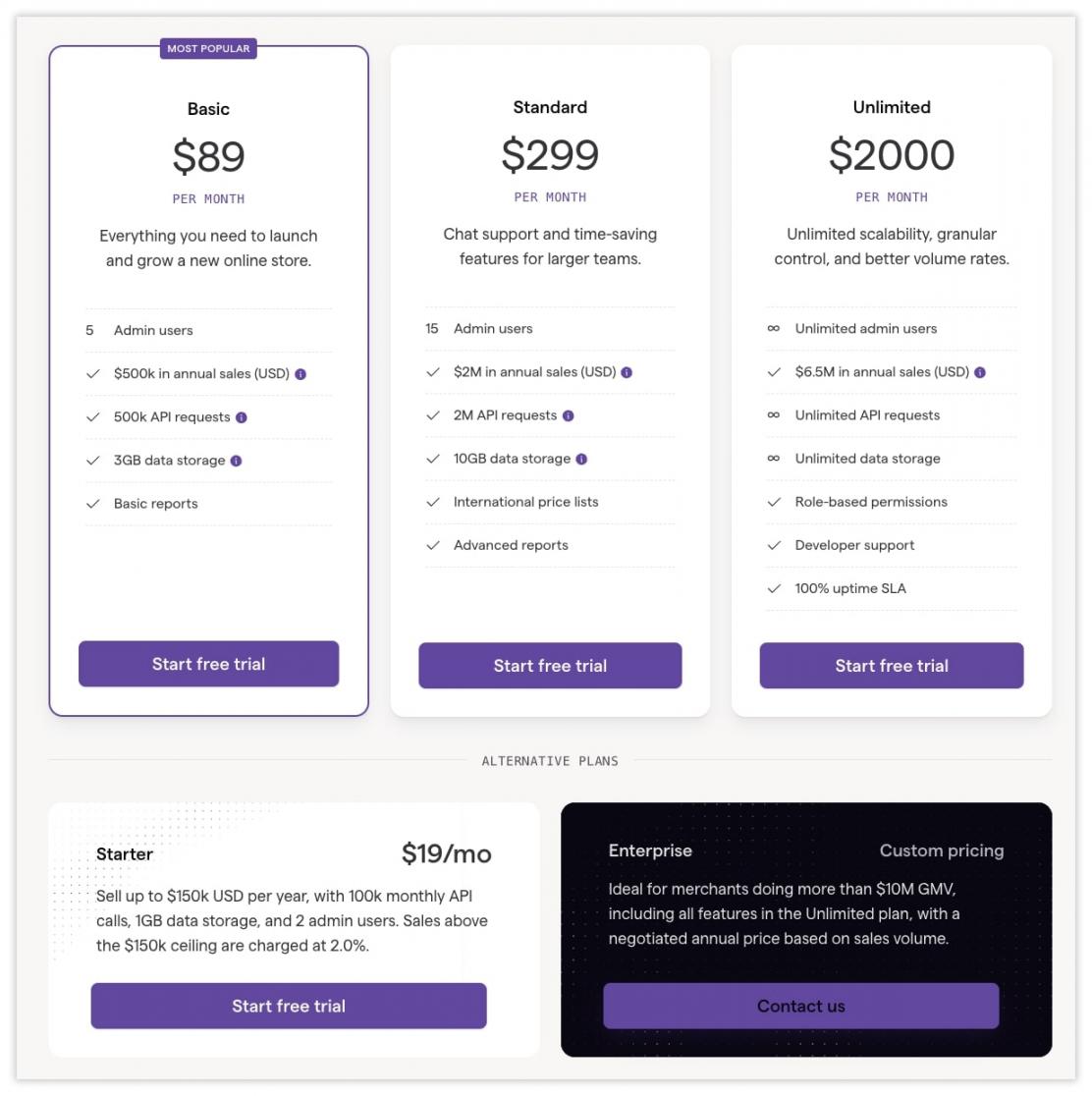
Image via Swell
Tool Level
- Beginner
Usability
- Easy to use
Pro Tip: Leverage Swell’s support for international payments to ease checkout procedures for all your customers no matter their location.
9. Nacelle
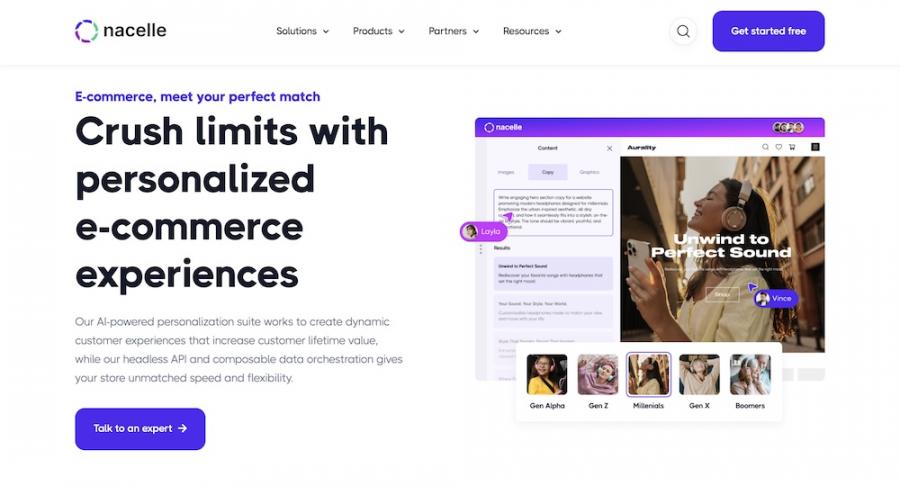
Image via Nacelle
Nacelle is another option that ranks highly among the best headless ecommerce platforms. It fits into your existing tech stack, rather than replacing it. So, if you’re looking for a platform to provide headless ecommerce functionalities without migrating, Nacelle is a good option.
Although Nacelle is a relatively new platform, its easy-to-use interface will give you a competitive edge in your headless commerce journey.
Nacelle is the best headless ecommerce platform when it comes to the use of a wide range of commerce tools for optimization. It can help you streamline and optimize the performance of your storefront.
This commerce engine gathers data from your existing business tools and re-indexes it in real time, bringing all your headless commerce solutions to a single streamlined platform. Below are its key features.
Key Features
- Provides headless ecommerce features by processing data using GraphQL API.
- Flexible architecture that allows you to merge it with your existing tech stack.
- Collects and re-indexes data from platforms like Shopify, Salesforce, and Netsuite.
- Provides pre-designed templates and built-in integrations with headless CMS tools like Sanity and Contentful.
- Features a modern PWA framework with wide integration capabilities.
- Utilizes an advanced caching system with a single API that results in fast page load speeds.
Pros
- Simple and organized back-end system
- Steady customer service support via phone, email, and ticket submission
- 30-day free trial
Cons
- May be too advanced for beginners
Pricing
- Nacelle offers customized pricing plans.
Tool Level
- Intermediate
Usability
- Moderately easy to use
Pro Tip: Take advantage of Nacelle’s large library of pre-designed templates to save time and energy.
10. Commerce Layer
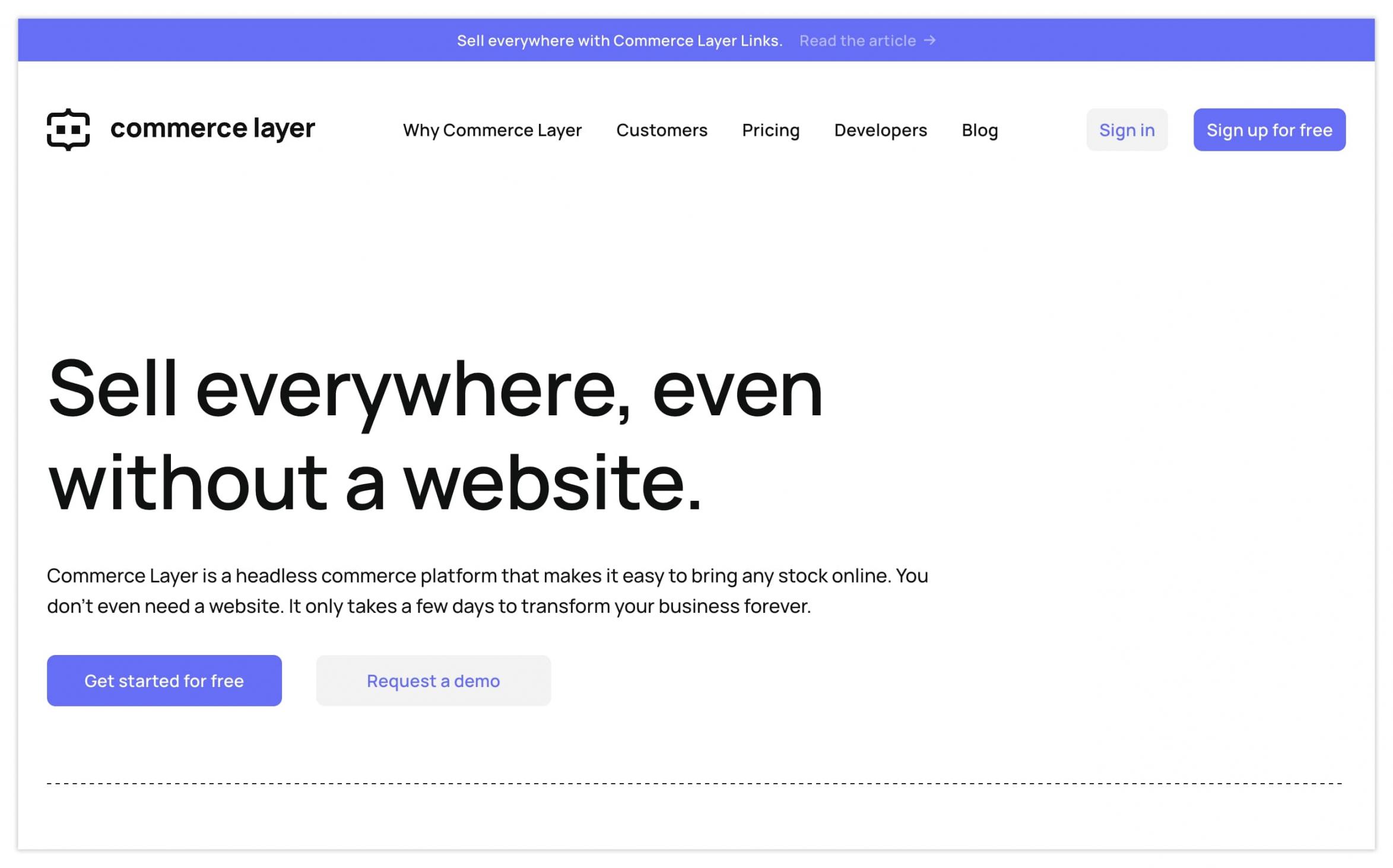
Image via Commerce Layer
Just as its tagline says, Commerce Layer simplifies headless ecommerce for business owners and marketers. It combines composable ecommerce technology with omnichannel capabilities that enable businesses to scale easily.
This is one of the best headless ecommerce platforms that applies a developer-first approach to ensure the back-end interface and functionalities are easy to use. It offers API-based functionalities and a range of about 38 third-party integrations.
Commerce Layer provides the ecommerce features you need to run your storefront, including inventory, catalog, and order management. Take a look at its key features, pros, and cons.
Key Features
- Supports multi-language features for English, German, French, and Italian.
- Supports third-party integrations with applications like Adyen, Amplience, Agility CMS, Contentful, ButterCMS, and more.
- Provides adequate training via live chat and documentation, which guides you through the implementation process.
- Allows you to either build your website from scratch or simply use it to add a shopping cart feature to an existing site.
- Boasts a high uptime of 99.99%.
- Gives access to speedy headless ecommerce features via over 300 API endpoints.
Pros
- Simple and intuitive user interface
- Free plan available
- Beginner-friendly
Cons
- Limited customer service options
Pricing
- Commerce Layer offers a free plan with limited access to benefits and a customized plan that you can contact sales to get a quote.
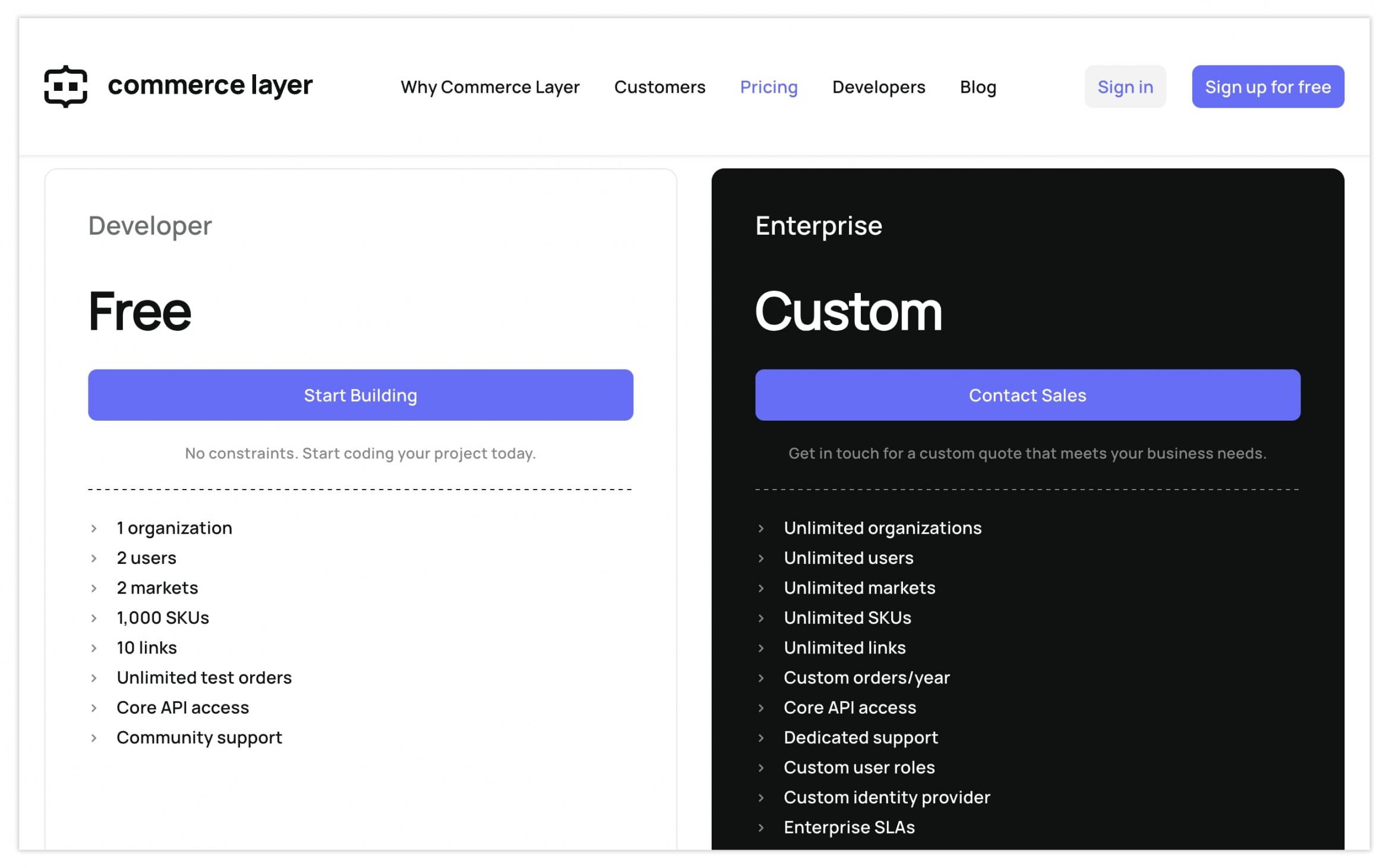
Image via Commerce Layer
Tool Level
- Beginner
Usability
- Easy to use
Pro Tip: Use Commerce Layer’s website-building features to create the right online store that meets the needs of your business.
11. LogiCommerce

Image via LogiCommerce
LogiCommerce is one of the oldest ecommerce platforms that provide both traditional and headless commerce features for businesses in several locations around the world.
It’s one of the best headless ecommerce platforms that give you complete control over your domain, with access to multiple storefronts. This enables you to expand your reach and gain access to a wider customer base.
If you’re looking for the best headless ecommerce platform with cloud-based deployment and up to 99% uptime, LogiCommerce is your go-to platform.
Key Features
- Provides product information management (PIM) tools, user management tools, data tracking, and other helpful ecommerce features.
- Integrates with AI and automation tools to facilitate faster and more efficient business operations.
- Provides flexible payment options by allowing integration with a wide range of payment gateways.
- Bulk purchase management features make it suitable for small and large enterprises.
- Features a built-in SEO suite to help you optimize your storefront and gain more visibility.
- Supports over 300 integrations with third-party applications like Amazon Pay, eBay, Stripe, PayPal, and Salesforce.
Pros
- Extensive integration capabilities
- Ecommerce SEO optimization
- Multi-language support
Cons
- Steep learning curve
- Limited customer support options
Pricing
LogiCommerce offers paid plans with the option for custom pricing
- Growth: $39 per month
- Business: Custom pricing

Image via LogiCommerce
Tool Level
- Intermediate
Usability
- Moderately easy to use
Pro Tip: LogiCommerce has one of the most advanced ecommerce AI features that you can use to automate repetitive tasks.
12. Fabric

Image via Fabric inc
Fabric is an innovative headless ecommerce platform that operates based on a cloud-first modular structure. It appears in our best headless ecommerce platform list because it enables users to decouple the UI from the database and allow storefront customization without back-end limitations.
Check out its key features to learn why it’s on our list of the top headless ecommerce platforms.
Key Features
- Utilizes AI-powered insights to provide sales and marketing metrics and make data-driven business decisions.
- Creates a cohesive ecommerce environment with bulk order management, inventory management, and cataloging.
- Features a robust suite of headless ecommerce APIs and microservices-based functionalities for easy storefront customization.
- Provides a resource library, FAQ portal, knowledge base, and API documentation to provide adequate training.
- Provides customizable CMS integrations and other third-party integrations.
- Integrates with payment gateways like PayPal, Amazon Pay, Stripe, and Apple Pay.
Pros
- Great for scalability
- Robust data security features
Cons
- Does not provide 24/7 customer support
Pricing
Fabric offers four price plans:
- AI DOM: $4,500 per month (8-12 week deploy)
- AI Omni: $3,000 per month (4-6 week deploy)
- AI Product Catalogue: (4 week deploy)
- Enterprise: Custom pricing

Image via Fabric
Tool Level
- Intermediate
Usability
- Moderately easy to use
Pro Tip: Take advantage of Fabric’s rich resource library, FAQ sections, API documentation, and knowledge base for training yourself.
13. Infosys Equinox
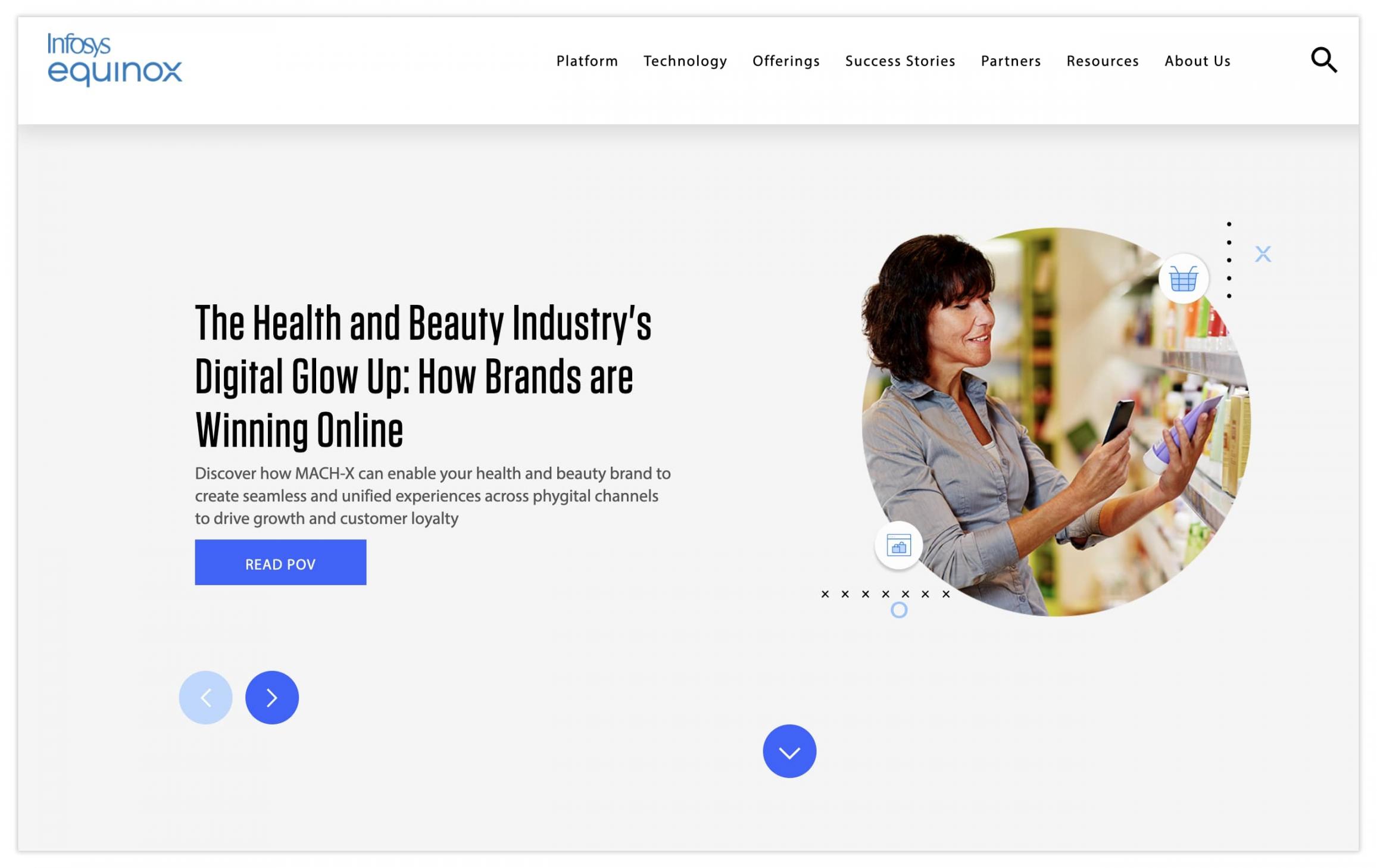
Image via Infosys Equinox
Infosys Equinox is among the best headless ecommerce platforms that provide a full suite of microservices-based features. Its business solutions are tailored to adequately meet the needs of B2C, B2B, and B2X businesses.
This headless ecommerce platform claims to be 30% faster than other platforms with MACH architecture and boasts a 99.99% uptime. So if you’re looking for the best headless ecommerce platform that deploys its services quickly, this is a good pick.
Infosys Equinox provides customization features for merchandising, inventory, catalog, and other storefront functionalities. Its headless feature gives you full creative control to design your storefront the way you want. Here are its key features.
Key Features
- Has a customer-centric user interface with intuitive features.
- Features a drag-and-drop editor for easy customization without any coding required.
- Provides ebooks, videos, articles, and other learning materials to guide you through the implementation process.
- Integrates with a wide network of over 25 leading technology partners including shipping, analytics, and payment service providers.
- Supports other third-party integrations with IoT devices, voice platforms, social media channels, and other consumer touchpoints.
Pros
- Wide customization options
- Beginner-friendly
Cons
- Limited customer service options
Pricing
- Infosys Equinox offers a demo version and customized pricing plans.
Tool Level
- Beginner
Usability
- Easy to use
Pro Tip: You can use the huge library of training materials provided by Infosys Equinox to understand how the platform works so you can get the best out of it.
FAQ
Q1. What is a headless ecommerce platform?
A. A headless ecommerce platform uses a decoupled ecommerce model where the front-end presentation layer is separated from the back end. These two functionalities are only connected via application programming interfaces (APIs).
Headless architecture allows marketers to customize unique storefronts based on their business needs, which is not usually possible via traditional ecommerce platforms.
Q2. What is the #1 ecommerce platform?
A. Due to unique business needs, there are no one-size-fits-all ecommerce tools or perfect ecommerce platforms. However, some of the leading ecommerce platforms include:
- Shopify
- BigCommerce
- Corecommerce
- Wix
- Squarespace
Q3. Is Shopify headless?
A. Shopify is the best headless ecommerce platform that developers can use to integrate third-party applications via its GraphQL storefront API.
Shopify’s headless ecommerce plan, Shopify Plus, gives you full access to unlimited storefront customizations and third-party integrations with CRM, ERP, and PIM tools.
Q4. How much does Shopify cost?
A. Shopify's headless ecommerce features can be accessed at a starting price of $2,500.
The cost of going headless with Shopify depends on the volume of your user base and your unique business requirements. The higher your business volume is, the higher the cost.
Q5. Is headless CMS good for ecommerce?
A. Utilizing headless CMS platforms in your business provides a flexible and scalable way to manage content across various digital channels. Here are some of the best headless CMS platforms you can implement in your business.
- Amplience
- Contentful
- Vue Storefront
- Directus
- Strapi
- Sanity
- ButterCMS
- Cockpit
- GraphCMS
Q6. Is headless commerce worth it?
A. Headless commerce is worth exploring because it provides marketers with unlimited possibilities for customization, giving them full creative control over their storefront designs.
The best headless ecommerce also allows business owners to easily scale their business while providing unique consumer experiences across several touch points. This enhances customer satisfaction and drives more sales.
However, although headless commerce is beneficial, it may not be suitable for startups as it requires more technical knowledge than that required for traditional ecommerce platforms. It also costs more.
Q7. Is headless ecommerce good for SEO?
A. Headless CMS allows you to centrally manage your content, which can be beneficial for SEO. It also gives you the flexibility to create the necessary SEO fields for your content while putting you ahead on SERPs.
Q8. How do I start a headless Shopify store?
A. If you’re not experienced enough, you can establish a headless store via Shopify by utilizing the services of an agency or front-end service provider. However, if you have software development experience, here are the basic steps to follow:
- Select a front-end tech stack
- Familiarize yourself with the Shopify storefront API
- Generate an access token
- Build and customize your storefront
Ready to Explore These Recommended Headless ecommerce Platforms?
Headless ecommerce platforms provide marketers with a range of benefits, including speedy content delivery, more flexibility, customization, and enhanced user experience.
If you’re looking to scale your business in 2025, embracing the headless approach could be a great place to start.
So, are you ready to adopt the headless ecommerce model? If you are, which of the recommended headless ecommerce platforms will you be implementing in your business model?
Do you have any more questions about headless ecommerce platforms? Drop a comment below. Good luck!





